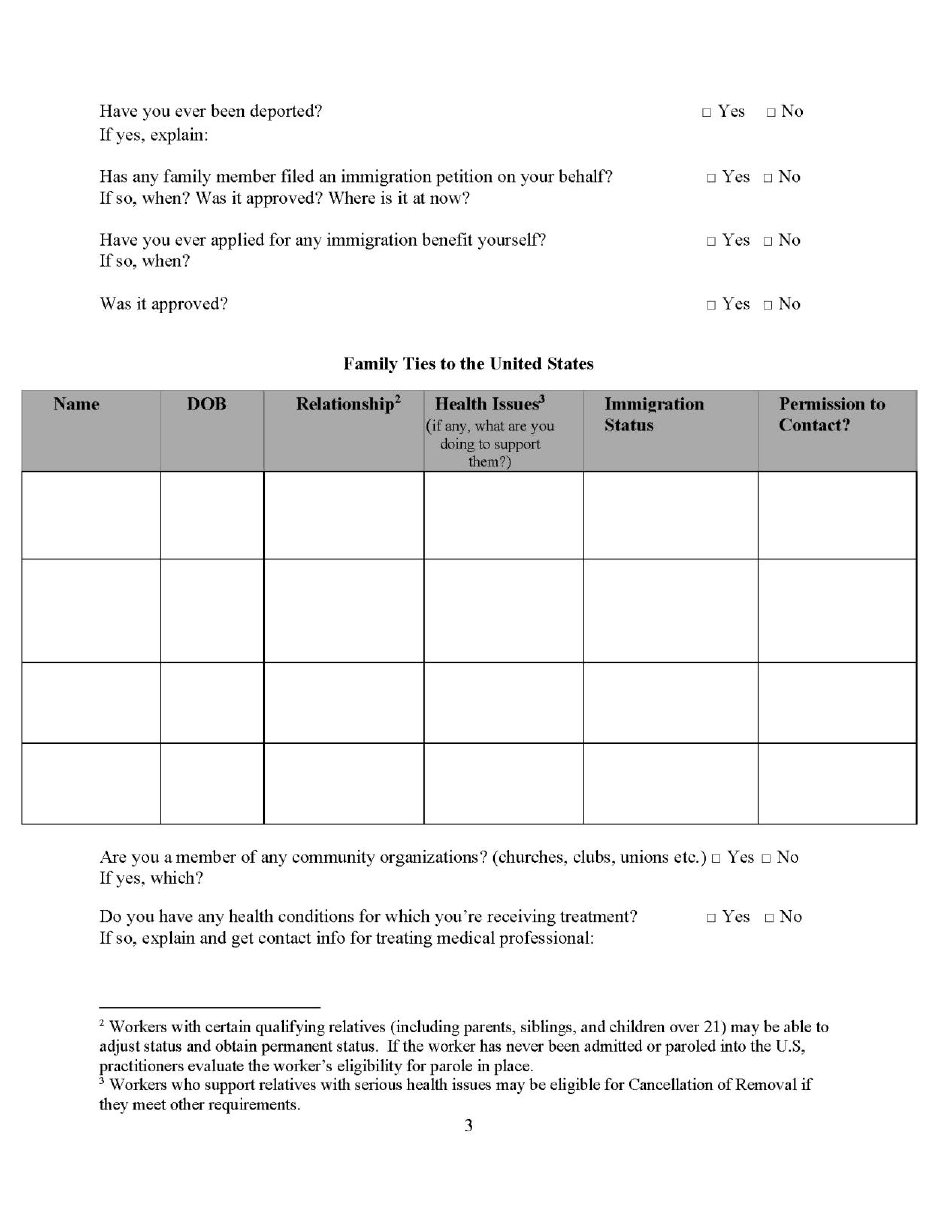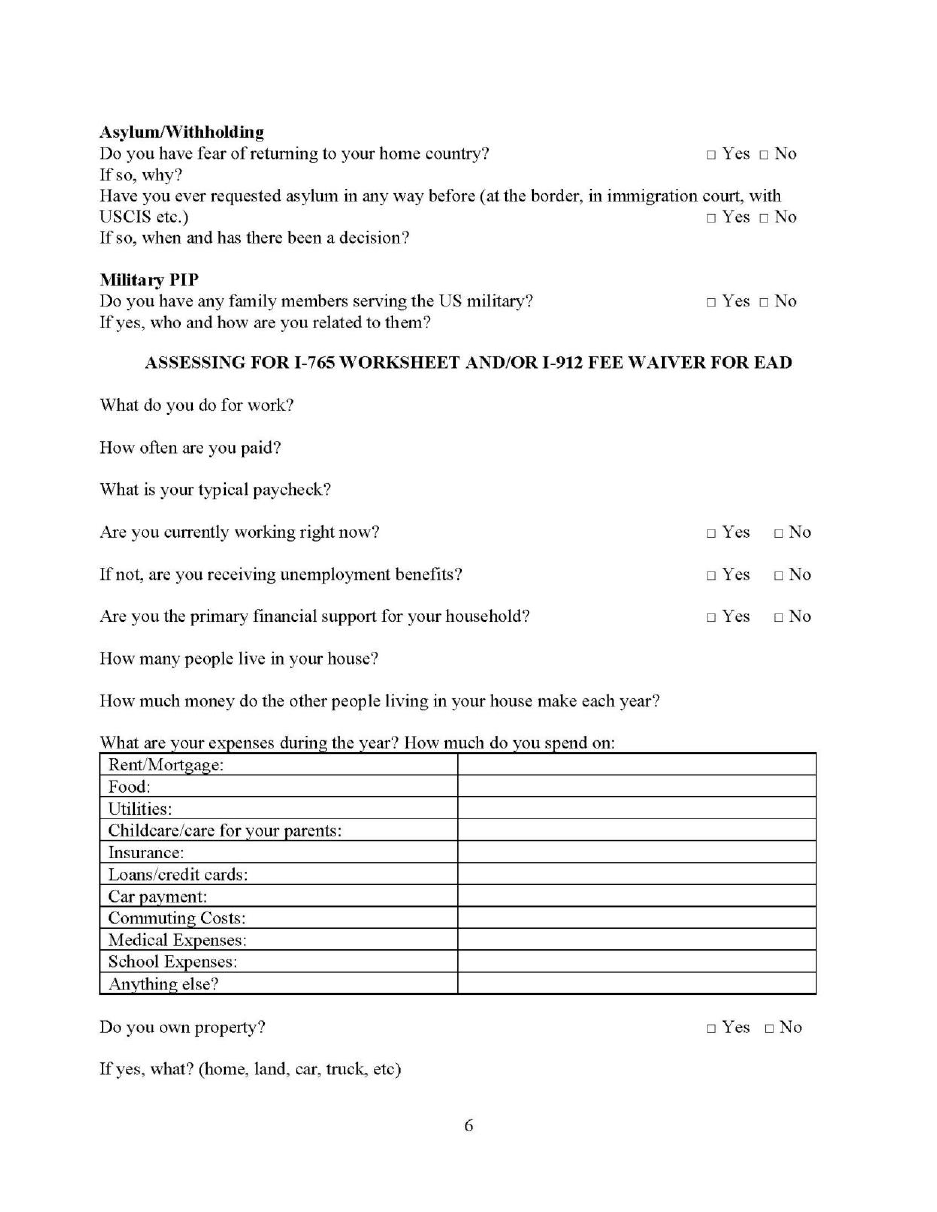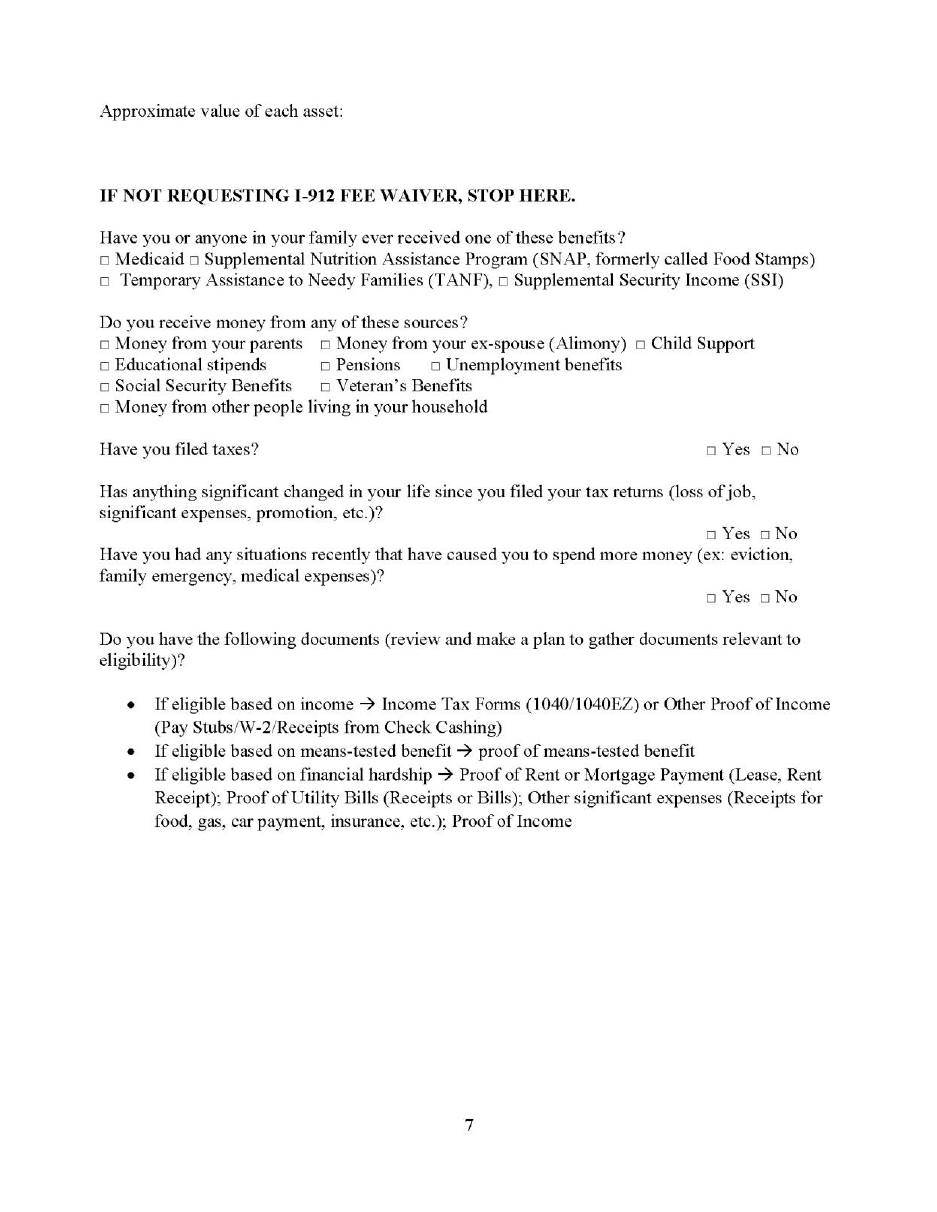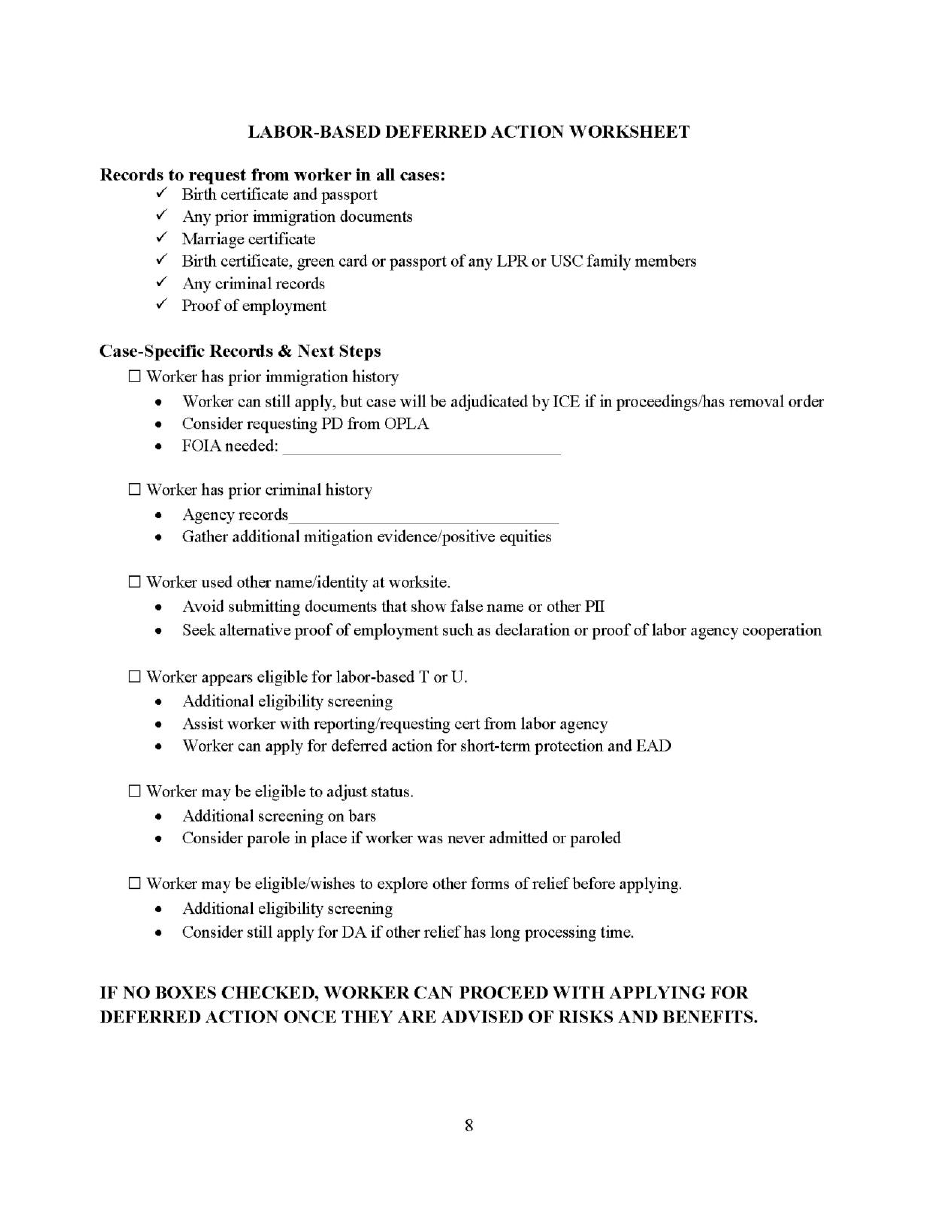
1
Practice Manual: Labor-Based Deferred Action
1
March 24, 2023
I. Introduction _____________________________________________________________ 2
II. Applying for Labor-Based Deferred Action ____________________________________ 3
A. What is Deferred Action? _______________________________________________________ 3
B. Who is Eligible for Labor-Based Deferred Action? __________________________________ 5
1. Identifying and Reporting Labor and Employment Law Violations ____________________________ 7
2. Obtaining a Labor or Employment Agency Statement of Interest _____________________________ 10
C. Screening & Counseling for Labor-Based Deferred Action __________________________ 13
1. Immigration Screening Interview ______________________________________________________ 13
2. Understanding Immigration and Criminal History—FOIAs & Other Record Requests ____________ 15
3. Counseling _______________________________________________________________________ 17
D. Preparing a Labor-Based Deferred Action Application _____________________________ 20
1. Contents of Deferred Action and Employment Authorization Packet __________________________ 21
2. Jurisdiction Over the Deferred Action Application—USCIS vs. ICE __________________________ 26
3. Timing & Expedite Requests _________________________________________________________ 27
4. Follow-Up & Troubleshooting ________________________________________________________ 28
5. Responding to Requests for Evidence (RFE) _____________________________________________ 29
6. Approval of Labor-Based Deferred Action ______________________________________________ 29
7. Denials __________________________________________________________________________ 29
E. Special Circumstances _________________________________________________________ 30
1. Labor-Based Deferred Action Applicants with Significant Negative Equities (Criminal/Immigration
History) _______________________________________________________________________________ 30
2. Applying for only Labor-Based Deferred Action, without Applying for Work Authorization _______ 30
1
The manual is intended for authorized immigration practitioners and is not a substitute for independent
legal advice provided by immigration practitioners familiar with a client’s case. Practitioners should
independently confirm whether the law has changed since the date of this publication. The authors of this
practice manual are Mary Yanik (Tulane Immigrant Rights Clinic), Jessica Bansal (Unemployed Workers
United), Ann Garcia (National Immigration Project (NIPNLG)), and Lynn Damiano Pearson (National
Immigration Law Center). The authors would like to thank Bliss Requa-Trautz (Arriba Las Vegas
Workers Center), Cal Soto (National Day Laborer Organizing Network), Debbie Smith and Claudia
Lainez (Service Employees International Union), Shelly Anand, Elizabeth Zambrana, and Alessandra
Stevens (Sur Legal Collaborative), Angel Graf (Immigration Center for Women and Children), Stacy
Tolchin (Law Offices of Stacy Tolchin), Audrey Richardson (Greater Boston Legal Services), Anna Hill
Galendez (Michigan Immigrant Rights Center), Michelle Lapointe (National Immigration Law Center),
Lisa Palumbo (Legal Aid Chicago), Kristen Shepherd (University of Georgia School of Law Community
Health Partnership Clinic), Laura Garza (Arise Chicago), and Christina Maloney (Centro de los Derechos
del Migrante, Inc.) for their review and contributions to the practice manual.

2
III. Subsequent Requests for Deferred Action after Initial Approval (Renewals) _______ 32
IV. Other Types of Immigration Relief Stemming from Labor Disputes______________ 33
A. Prosecutorial Discretion in Removal Proceedings __________________________________ 33
B. Parole in Place _______________________________________________________________ 34
C. Requests for Noncitizens Presently Outside the United States ________________________ 36
D. Other related relief–T & U Nonimmigrant Visas ___________________________________ 38
1. Identifying Labor Trafficking & Eligibility for T Nonimmigrant Status ________________________ 40
2. Identifying Labor-Based Qualifying Crimes for Eligibility for U Nonimmigrant Status ___________ 40
V. Frequently Asked Questions _______________________________________________ 42
A. Advance Parole & Travel Outside the United States ________________________________ 42
B. Civil Rights Cases & Private Rights of Action _____________________________________ 43
VI. Appendices ___________________________________________________________ 44
Appendix 1: Timeline of Prior DHS Guidance on Labor Disputes _________________________ 44
Appendix 2: Template Request for a Statement of Interest from Labor or Employment Agency47
Appendix 3: Intake Form for Labor-Based Deferred Action and Employment Authorization __ 49
Appendix 4: Sample Labor Agency Statements of Interest _______________________________ 57
Appendix 5: Sample Cover Letter Requesting Labor-Based Deferred Action _______________ 57
Appendix 6: Sample Declaration Regarding Employment and Request from Labor-Based
Deferred Action Applicant _________________________________________________________ 57
Appendix 7: Sample I-765 Worksheet ________________________________________________ 57
Appendix 8: Redacted Labor-Based Deferred Action Approval Letter _____________________ 57
I. Introduction
On January 13, 2023, the Department of Homeland Security announced “a streamlined and
expedited deferred action request process” for non-citizen workers who experience or witness
labor rights violations [hereinafter, “Labor-Based Deferred Action”].
2
Guidance on the process
emphasizes DHS’s role in supporting federal, state, and local labor and employment agency
efforts to enforce labor and employment law and hold abusive employers accountable. Labor-
Based Deferred Action confers deferred action and work authorization for a two-year period.
Those approved may make subsequent requests for additional two-year grants of Labor-Based
Deferred Action if supported by the labor or employment agency. Labor-Based Deferred Action
represents the culmination of over a decade of worker-led organizing to demand concrete
protections against immigration-based retaliation by exploitative employers. It is a testament to
the courage of immigrant workers who have stood up for workers’ rights in the face of retaliatory
immigration enforcement.
2
Press Release, U.S. Dep’t of Homeland Sec., DHS Announces Process Enhancements for Supporting
Labor Enforcement Investigations (Jan. 13, 2023), https://www.dhs.gov/news/2023/01/13/dhs-announces-
process-enhancements-supporting-labor-enforcement-investigations [hereinafter “DHS Announcement”].

3
This Practice Manual is intended for immigration practitioners representing workers applying for
Labor-Based Deferred Action. Part II describes who is eligible and explains the application
process, including components of the application packet and practice advice. Part III addresses
subsequent requests (renewals) after the initial two-year period. Part IV describes related relief,
such as prosecutorial discretion in removal proceedings, parole, and U and T Visas. Finally, Part
V answers frequently asked questions. Publicly available appendices begin with a timeline of key
DHS memoranda and agreements that incrementally addressed the conflict between immigration
and labor enforcement, laying the groundwork for the January 13 guidance, and also include a
template request for a Statement of Interest from a labor or employment agency and an intake
form. Practitioners may view the five additional appendix documents referenced throughout this
practice manual by completing the following form:
https://tulane.co1.qualtrics.com/jfe/form/SV_3TYmLAhHX5k2hBY.
For immigration-related technical assistance questions on Labor-Based Deferred Action,
practitioners may contact: Mary Yanik (myanik@tulane.edu), Lynn Damiano Pearson
(daforworkers@nilc.org), and Ann Garcia (members of the National Immigration Project
(NIPNLG) only, ann@nipnlg.org).
II. Applying for Labor-Based Deferred Action
A. What is Deferred Action?
Deferred action is a discretionary determination by DHS to defer removal as an act of
prosecutorial discretion.
3
The legacy Immigration and Naturalization Service formally
recognized deferred action as a form of prosecutorial discretion in 1975, indicating that deferred
action was warranted when “adverse action would be unconscionable because of the existence of
appealing humanitarian factors.”
4
While DHS has therefore long held authority to consider
deferred action for a variety of humanitarian reasons, the application process has been obscure.
DHS has not published information on how to apply for deferred action generally, although it has
sometimes provided policy guidance on how the agency will consider requests from certain
applicants, such as families of U.S. Armed Forces members.
5
3
See U.S. Dep’t of Homeland Sec., DHS Support of the Enforcement of Labor and Employment Laws,
https://www.dhs.gov/enforcement-labor-and-employment-laws (last updated Feb. 3, 2023) [hereinafter
“DHS FAQ”]. While the DHS guidance issued on January 13, 2023 specifically references both deferred
action and parole-in-place as forms of prosecutorial discretion available to the agency, the Labor-Based
Deferred Action Process relies exclusively on deferred action. Id. For more on parole in place, see infra
Part IV Section B.
4
(Legacy) Immigration and Naturalization Service, Operating Instructions, O.I. § 103.1(a)(1)(ii) (1975).
5
See Memorandum from Jeh Johnson, Sec’y, U.S. Dep’t of Homeland Sec., to León Rodriguez, Dir.,
U.S. Citizenship & Immig. Servs., Families of U.S. Armed Forces Members and Enlistees (Nov. 20,
2014),
https://www.dhs.gov/sites/default/files/publications/14_1120_memo_parole_in_place.pdf; see also U.S.
Citizenship & Immig. Servs., Discretionary Options for Military Members, Enlistees, and their Families,
https://www.uscis.gov/military/discretionary-options-for-military-members-enlistees-and-their-families
(last updated Apr. 25, 2022).

4
DHS makes determinations to grant or deny deferred action on a case-by-case basis and a grant
of deferred action can be terminated at any time at the agency’s sole discretion. There is no
statutory or regulatory limit to the length of time for which deferred action can be granted.
However, historically, deferred action has been granted for periods of two to three years.
6
Individuals with deferred action are eligible for an employment authorization document with a
basic showing of economic necessity.
7
Through applying for employment authorization, or
separately, deferred action recipients can also apply for a Social Security card.
8
Social Security
cards issued to deferred action recipients state, “Valid for Work Only with DHS Authorization,”
because they do not establish employment eligibility on their own, so they must be presented
with evidence of employment authorization when used for employment eligibility verification.
9
Only noncitizens residing in the U.S. can seek deferred action. Deferred action does not
authorize entry into the U.S. Therefore, noncitizens who receive deferred action will not be able
to travel and re-enter the country without separate authorization.
10
A grant of deferred action authorizes the noncitizen’s presence in the United States. Therefore,
while deferred action does not cure unlawful presence already accrued for the purposes of the 3-
and 10-year bars, time spent in the U.S. under deferred action will not count toward the
accumulation of unlawful presence.
11
6
See Ben Harrington, Cong. Research Serv. R45158, An Overview of Discretionary Reprieves from
Removal: Deferred Action, DACA, TPS, and Others (2018),
https://crsreports.congress.gov/product/pdf/R/R45158; but see U.S. Citizenship & Immig. Servs.,
National Engagement - U Visa and Bona Fide Determination Process - Frequently Asked Questions,
https://www.uscis.gov/records/electronic-reading-room/national-engagement-u-visa-and-bona-fide-
determination-process-frequently-asked-questions (last updated Sept. 23, 2021) (stating that the initial
Bona Fide Determination Deferred Action grant is valid for four years).
7
8 C.F.R. § 274a.12(c)(14). While USCIS is not permitted to waive the employment authorization
application fee for applicants for DACA, 8 C.F.R. § 274a.12(c)(33), that provision does not prohibit fee
waiver for other types of deferred action, including Labor-Based Deferred Action.
8
The Social Security Administration and USCIS have now streamlined the process for requesting a SSN
such that relevant questions are included in the I-765. A SSN is automatically sent if employment
authorization is approved. For more on this streamlined process, as well as what to do if your client does
not receive the SSN, see Soc. Sec. Admin., Apply For Your Social Security Number While Applying For
Your Work Permit and/or Lawful Permanent Residency, https://www.ssa.gov/ssnvisa/ebe.html (last
visited March 10, 2023).
9
U.S. employers fill out Form I-9 for each person they hire to verify the employee’s identity and
employment authorization based on the documents they present. For more information about the I-9 form
and the list of acceptable documents, see U.S. Citizenship & Immig. Servs., I-9: Employment Eligibility
Verification (Dec. 20, 2022), https://www.uscis.gov/i-9.
10
It is not yet clear how USCIS will adjudicate requests for advance parole for travel from Labor-Based
Deferred Action recipients. For further discussion of advance parole, see infra Part V Section A.
11
Adjudicator’s Field Manual, U.S. Citizenship & Immig. Servs., ch. 40.9(b)(3)(J); Arizona Dream Act
Coal. v. Brewer, 855 F.3d 957, 974 (9th Cir. 2017) (en banc); Texas v. United States, 809 F.3d 134, 147–
48 (5th Cir. 2015) (explaining that deferred action recipients are “lawfully present” based on agency
memoranda); see also DHS FAQ, supra note 3 (“a noncitizen granted deferred action is considered
lawfully present in the United States for certain limited purposes while the deferred action is in effect”).

5
Those who receive deferred action, employment authorization, and a Social Security number are
eligible to receive valid state identification, including driver’s licenses, in every state.
12
Deferred
action grantees can receive Social Security benefits if they are otherwise entitled to them.
13
However, deferred action grantees are not considered “qualified aliens” for purposes of receiving
federal public benefits.
14
B. Who is Eligible for Labor-Based Deferred Action?
15
Labor-Based Deferred Action is available to “[n]oncitizen workers who are victims of, or
witnesses to, the violation of labor rights.”
16
As a threshold matter, to establish eligibility,
workers must provide “[a] letter or Statement of Interest from a [federal, state, or local] labor or
employment agency addressed to DHS supporting the request.”
17
[hereinafter, “Statement of
Interest”]. Applications submitted without a Statement of Interest will be rejected. Generally,
labor and employment agencies will issue Statements of Interest only in connection with agency
investigations or enforcement efforts (including, in some cases, closed investigations).
12
DHS Guidance on DACA makes clear that those with DACA or other deferred action are considered
lawfully present. See U.S. Citizenship & Immig. Servs., Consideration of Deferred Action for Childhood
Arrivals (DACA) Frequently Asked Questions (Nov. 3, 2022),
https://www.uscis.gov/humanitarian/consideration-of-deferred-action-for-childhood-arrivals-
daca/frequently-asked-questions#miscellaneous (see questions Q4, explaining that DACA is identical to
any other grant of deferred action, and Q5, explaining that those with deferred action are lawfully present
for the purposes of certain public benefits). This means that deferred action recipients can receive
federally recognized driver’s licenses or identification that are valid under the REAL ID Act. See Nat’l
Immigr. Law Ctr., REAL ID and Deferred Action for Childhood Arrivals (DACA) (Jan. 2023),
https://www.nilc.org/issues/daca/real-id-and-daca/. While some states have attempted to deny licenses to
noncitizens with deferred action, those efforts have been stymied by litigation or legislative action and all
states are currently issuing state identification to deferred action grantees. For information on further
developments in this area, see Nat’l Immigr. Law Ctr., Access to Driver’s Licenses for Immigrant Youth
Granted DACA (Jul. 22, 2020) https://www.nilc.org/issues/drivers-licenses/daca-and-drivers-licenses/.
13
Noncitizens in the U.S. must be in lawfully present to receive Social Security Benefits. See 42 U.S.C.
§ 402(y).
14
Personal Responsibility and Work Opportunity Reconciliation Act of 1996 (PRWORA), Pub. L. No.
104–193, 110 Stat. 2105 (Aug. 22, 1996), § 431(b). For more information on benefit eligibility, see Tanya
Broder, Gabrielle Lessard, & Avideh Moussavian, Nat’l Immigr. Law Ctr., Overview of Immigration
Eligibility for Federal Programs (Oct. 2022), https://www.nilc.org/issues/economic-support/overview-
immeligfedprograms/ - _ftnref1.
15
This Section includes a cursory overview of labor and employment aspects of the Labor-Based
Deferred Action process. A separate practice resource is forthcoming that will specifically focus on the
labor and employment issues involved in Labor-Based Deferred Action. It will be co-authored by Jobs
with Justice, the National Employment Law Project (NELP), and the National Immigration Law Center
(NILC).
16
DHS Announcement, supra note 2.
17
DHS FAQ, supra note 3.

6
To be eligible for Labor-Based Deferred Action, a worker must therefore: (1) Witness or
experience a violation of labor or employment law or other labor dispute;
18
(2) File a complaint
with a federal, state, or local labor or employment agency or identify an existing agency
investigation related to the violation;
19
and (3) Obtain a Statement of Interest.
Labor and employment agency complaint and Statement of Interest request processes are
generally intended to be accessible to workers proceeding pro se. However, in practice,
assistance from experienced attorney or non-attorney advocates is often necessary to ensure a
strong complaint, thorough investigation, and successful request.
20
Workers centers, unions,
labor organizers, and labor and employment attorneys are often experts in this area. Immigration
practitioners are not typically involved unless they are experienced in labor and employment law
or partner with others who are. Accordingly, in most cases, immigration practitioners will
become involved in the case after the worker has requested or obtained a Statement of Interest
from the labor agency.
21
18
Department of Labor (DOL) guidance on the process for requesting DOL support for Labor-Based
Deferred Action describes workers who experience or witness violations of labor or employment law as
“workers involved in labor disputes.” U.S. Dep’t of Labor, Process for Requesting Department of Labor
Support for Requests to the Department of Homeland Security for Immigration-Related Prosecutorial
Discretion During Labor Disputes (Jul. 6, 2022),
https://www.dol.gov/sites/dolgov/files/OASP/files/Process-For-Requesting-Department-Of-Labor-
Support-FAQ.pdf [hereinafter “DOL FAQ”]. The term “labor dispute” is broadly defined as “a labor-
related dispute between the employees of a business of organization and the management or ownership of
the business or organization concerning the following employee rights: the right to be paid the minimum
legal wage, a promised or contracted wage, and overtime; the right to receive family medical leave and
employee benefits to which one is entitled; the right to have a safe workplace and to receive
compensation for work-related injuries; the right to be free from unlawful discrimination; the rights to
form, join or assist a labor organization, to participate in collective bargaining or negotiation, and to
engage in protected concerted activities for mutual aid or protection; the rights of members of labor
unions to union democracy, to unions free of financial improprieties, and to access to information
concerning employee rights and the financial activities of unions, employers, and labor relation
consultants; and the right to be free from retaliation for seeking to enforce the above rights.”
U.S. Dep’t of Homeland Sec. and U.S. Dep’t of Labor, Revised Memorandum of Understanding between
the Departments of Homeland Security and Labor Concerning Enforcement Activities at Worksites (Dec.
7, 2011), https://www.dol.gov/sites/dolgov/files/OASP/DHS-DOL-MOU_4.19.18.pdf.
19
Note that some labor and employment agencies allow anonymous and/or third-party complaints.
20
This is particularly true where workers face barriers to navigating agency processes (such as fear of
government officials in the U.S., literacy, and language).
21
Immigration practitioners are nonetheless encouraged to screen potential clients for labor abuses as they
may identify potential eligibility for Labor-Based Deferred Action or other types of labor-based
immigration relief. Practitioners should consider identifying labor rights organizations in their
communities where they can refer workers who need assistance reporting labor and employment law
violations and potentially requesting Statements of Interest. For further discussion of screening best
practices, see infra Section II Part C.

7
1. Identifying and Reporting Labor and Employment Law Violations
Generally, labor and employment agencies issue Statements of Interest only in connection with
agency investigations or enforcement efforts. If a worker has experienced or witnessed a
violation that relates to an existing agency investigation or enforcement effort, the worker does
not need to file a new complaint with the agency before requesting a Statement of Interest.
Rather, as described below in Part II Section B, the worker can simply describe how their
experience relates to the agency’s existing investigation or enforcement effort.
22
If a worker has
experienced or witnessed a violation that is not already the subject of an agency investigation or
enforcement effort, the worker may be able to initiate an investigation by filing their own
complaint.
23
While a full discussion of labor and employment law is beyond the scope of this Practice
Manual, Table 1 provides a very basic overview of some of the principal federal laws enforced
by key federal labor and employment agencies, with links to agency complaint processes.
Practitioners should be aware that coverage varies from law to law and is sometimes limited to
employers with a certain number of employees or volume of business, and/or employees with a
22
See U.S. Equal Employment Opportunity Commission, EEOC’s Support for Immigration-Related
Deferred Action Requests to the DHS Frequently Asked Questions, https://www.eeoc.gov/faq/eeocs-
support-immigration-related-deferred-action-requests-dhs (last visited Mar. 10, 2023) [hereinafter “EEOC
FAQ”].
23
Often, the best way to determine whether there is already a pending investigation is to ask the worker if
they are aware of anyone else filing a complaint about the violation. In addition, it may be helpful to
search publicly available case databases maintained by the NLRB, Nat’l Labor Relations Bd., Cases &
Decisions, https://www.nlrb.gov/cases-decisions (last visited Mar. 10, 2023), and the DOL, U.S. Dep’t of
Labor, Data Enforcement, https://enforcedata.dol.gov/views/search.php (last visited Mar. 10, 2023). For a
general guide on intake to screen for labor disputes relevant to prosecutorial discretion, see Screening for
Civil and Labor Rights Violations in Support of Prosecutorial Discretion (Aug. 5, 2021),
https://www.nelp.org/wp-content/uploads/Intake-Guide-Screening-Civil-and-Labor-Rights-Violations-in-
Support-of-Prosecutorial-Discretion-8-5-2021.pdf.
1. Witness or
Experience a
Labor Violation or
Participate in a
Labor Dispute
2. File Labor
Agency Complaint
3. Obtain Labor
Agency Statement
of Interest
4. Screening &
Counseling for
Individual
Workers Within
Scope of Labor
Agency Statement
5. File Individual
Application(s) for
Deferred Action &
Work Permit
6. File Subsequent
Requests for
Deferred Action &
Work Permit

8
certain amount of time worked.
24
State and local labor laws may provide more expansive labor
protections than federal law, and state and local labor agencies often have their own complaint
processes.
Table 1: Overview of Principal Federal Labor and Employment Laws and Enforcing Agencies
AGENCY
LAWS ENFORCED
EXAMPLES OF
VIOLATIONS
TYPICAL STATUTE
OF LIMITATIONS
COMPLAINT
PROCESS
National Labor
Relations
Board (NLRB)
National Labor
Relations Act
• Right to
unionize
• Right to
organize and
engage in
“protected
concerted activity,”
free of retaliation
An employer cuts a
worker’s hours for
talking to co-workers
about poor working
conditions.
An employer fires a
worker for
supporting the union.
6 months
https://www.nlrb.g
ov/
guidance/fillable-
forms
USDOL Wage
and Hour
Division
(WHD)
Fair Labor
Standards Act
(FLSA)
• Minimum wage
• Overtime
• Child labor
• Retaliation
Workers work over
40 hours in a
workweek but do not
receive overtime
pay.
2 years (3 years for
willful violations)
https://www.dol.g
ov
/agencies/whd/
contact/complaints
Family Medical
Leave Act
• Unpaid, job-
protected leave for
certain family and
medical needs
A new parent is fired
for requesting 12
weeks off to care for
their newborn.
2 years (3 years for
willful violations)
https://www.dol.g
ov
/agencies/whd/
contact/complaints
Labor standards
protections of H-2A,
H-2B, and H-1B
programs
• Wage, housing,
transportation, and
disclosure standards
An employer pays
their H-2A
agricultural workers
by piece rate, and the
resulting wage is
below the local
prevailing wage for
U.S. workers in the
same occupation.
Best to file as soon
as possible, and
within 2 years,
because of legal
ambiguity on the
statute of
limitations
https://www.dol.g
ov
/agencies/whd/
contact/complaints
24
For example, the Fair Labor Standards Act (FLSA) applies only to employees who: (1) are involved in
interstate commerce; (2) work for a business that has at least two employees and does an annual business
of at least $500,000; or (3) work for hospitals or certain businesses providing medical or nursing care.
U.S. Dep’t of Labor, Fact Sheet #14: Coverage Under the Fair Labor Standards Act (July 2009),
https://www.dol.gov/agencies/whd/fact-sheets/14-flsa-coverage.

9
USDOL
Occupational
Safety and
Health
Administration
(OSHA)
Occupational Safety
and Health Act
• Health and
safety standards
• Whistleblower
protections
A construction
worksite fails to
provide proper fall
protection training.
An employer gives a
worker a less
favorable job
assignment because
they filed an OSHA
complaint.
6 months for health
and safety
violations
30-180 days for
whistleblower
violations,
depending on type
of violation
https://www.osha.
gov/
workers/file-
complaint
USDOL Office
of Federal
Contract
Compliance
Programs
(OFCCP)
Executive Order
11246 and other
anti-discrimination
laws and regulations
applicable to federal
contractors and
subcontractors
• Prohibiting
discrimination based
on race, color, sex,
sexual orientation,
gender identity,
religion, national
origin, or veteran
status
• Prohibiting
retaliation for
inquiring about or
disclosing
compensation
Note that OFCCP
refers complaints
alleging individual
discrimination based
on race, color,
religion, sex, or
national origin to
EEOC.
A business with
federal government
contracts fires a
worker for talking
with co-workers
about how much she
is paid.
A business with
federal government
contracts
discriminates against
workers based on
sexual orientation.
180 days for
discrimination
based on race,
color, religion, sex,
sexual orientation,
gender identity,
national origin, or
compensation
inquiries/disclosure
300 days for
discrimination
based on disability
or protected veteran
status
https://www.dol.g
ov/agencies/ofccp/
contact/file-
complaint

10
Equal
Employment
Opportunity
Commission
(EEOC)
Federal Anti-
Discrimination Laws
(inc. Title VII and
the ADA)
• Prohibiting
discrimination based
on race, color,
religion, sex, gender
identity, sexual
orientation, national
origin, age, or
disability
An employer uses
racial slurs, creating
a hostile work
environment.
180 or 300 days
depending on
state/locality
https://www.eeoc
.gov/
filing-charge-
discrimination
2. Obtaining a Labor or Employment Agency Statement of Interest
a) What is a Labor or Employment Agency Statement of Interest?
A labor or employment agency Statement of Interest is a written request from a federal, state, or
local labor or employment agency “asking DHS to consider exercising its discretion on behalf of
workers employed by companies identified by the agency as having labor disputes related to
laws that fall under its jurisdiction.”
25
Importantly, Statements of Interest generally identify a
workplace or employer, rather than specific worker(s). A Statement of Interest typically asks
DHS to use its discretion to protect workers who are or were employed at a particular worksite(s)
or by a particular employer during a time relevant to an agency investigation (and who are
therefore potential victims or witnesses). For example:
Example 1: The EEOC is investigating charges from several workers that, from
November 2021 through the present, their employer subjected them to harassment due to
their race and national origin. The EEOC issues a Statement of Interest requesting a
favorable exercise of prosecutorial discretion for workers employed by the employer at
any time from November 2021 through the present.
Example 2: DOL’s Wage and Hour Division is investigating violations of the Fair Labor
Standards Act’s minimum wage and overtime provisions by a company with worksites
throughout the state of Ohio. DOL issues a Statement of Interest requesting a favorable
exercise of prosecutorial discretion for workers employed by the company at any
worksite in Ohio over the past three years.
Example 3: The NLRB is investigating unfair labor practice charges filed by several
employees. The NLRB issues a Statement of Interest requesting a favorable exercise of
prosecutorial discretion for workers employed by the employer from January 2021
through the present, the time-period during which the employer allegedly engaged in the
unlawful practices.
25
See DHS Announcement, supra note 2.

11
Redacted Statements of Interest from each federal labor agency are available by request only in
Appendix 4.
Practitioners should note that Labor-Based Deferred Action does not currently provide any
means for family members to receive deferred action as derivatives of the principal beneficiary.
In the vast majority of cases so far, Statements of Interest covered only workers, not family
members.
26
b) How to Obtain a Statement of Interest
Labor and employment agency processes to request Statements of Interest vary.
To request a Statement of Interest from the NLRB, workers or their advocates or representatives
should send a written request to the Board Agent assigned to their case, the Regional Director,
and the Immigration Coordinator (if known).
27
To request a Statement of Interest from the U.S. DOL (including the Wage and Hour Division,
the Occupational Safety and Health Administration, and the Office of Federal Contract
Compliance Programs), workers or their advocates or representatives should send an email to
state[email protected] describing: (1) “the labor dispute and how it is related to the laws
enforced by DOL;” (2) related retaliation the workers witnessed or experienced, if any; and (3)
how the chilling effect of potential immigration consequences may deter workers from reporting
violations or otherwise cooperating with DOL. Note that while workers should include
information about retaliation where applicable, there is no requirement that worker have
witnessed or experienced retaliation in order to qualify for a Statement of Interest. DOL’s
Frequently Asked Questions provides further details and requirements.
28
To request a Statement of Interest from the EEOC, workers or their advocates or representatives
should contact the District Director and Regional Attorney at their local EEOC Field Office.
Requests should: (1) “[I]dentify the workplace involved in the relevant EEOC investigation or
litigation;” (2) provide “information about retaliation, whether immigration-related or otherwise,
or fear of such retaliation, that is likely to deter employees from reporting to the EEOC or
26
The only exception was in a case involving deceased workers whose family members were potential
witnesses in the agency investigation. There is a strong argument that labor and employment agencies
should issue Statements of Interest covering workers’ family members whenever needed for workers to
feel safe reporting violations, participating in agency investigations, or otherwise exercising their labor
rights. The DOL appears to acknowledge this by recognizing that “undocumented workers who
experience labor law violations may fear that cooperating with an investigation will result in the
disclosure of their immigration status or that of family members, or that it will result in immigration-based
retaliation from their employers and adverse immigration consequences for themselves or their family.”
DOL FAQ, supra note 18 (emphasis added).
27
See Jennifer A. Abruzzo, Gen. Counsel, Nat’l Labor Relations Bd., Ensuring Rights and Remedies for
Immigrant Workers under the NLRA, Memo 22-01, (Nov. 8, 2021),
https://apps.nlrb.gov/link/document.aspx/09031d45835cbb0c; Joan Sullivan, Assoc. Gen. Counsel, Nat’l
Labor Relations Bd., Ensuring Safe and Dignified Access for Immigrant Workers to NLRB Processes,
OM 22-09 (May 2, 2022), https://apps.nlrb.gov/link/document.aspx/09031d458375a553.
28
See DOL FAQ, supra note 18.

12
participating in its investigations or litigation;” and (3) include the Requestor’s contact
information.
29
The EEOC’s Frequently Asked Questions provide further details and
requirements.
30
A template Statement of Interest request is included in Appendix 2. Note that the request need
not name specific workers and should not disclose any worker’s immigration status or contain
sensitive personally identifiable information. The request should, however, frame the time period
relevant to the labor or employment law violation, worksite(s), and employer(s) as broadly as
possible to cover all current and former employees who could potentially be victims of, or
witnesses to, the violation. Specifically, the request should list all relevant employers (including
any possible joint employers and subcontractors), all relevant worksites, and the relevant time
period (including the earliest date of evidence of a labor violation through the filing of the
agency complaint and anticipated further proceedings, including compliance and monitoring).
These details will define the scope of workers who are eligible to file for Labor-Based Deferred
Action, and so the request is a key opportunity to ask for the class of affected workers to be as
broad as possible. If the agency may be inclined to limit the scope of the Statement of Interest in
any way that might exclude potential witnesses, the request should explicitly address why the
Statement of Interest should be broad to prevent or counteract retaliation and facilitate the
participation of all potential witnesses.
As of the publication of this Practice Manual, no state and or local labor or employment agency
has yet published guidance for seeking a Statement of Interest. The absence of published
guidance does not mean an agency will not issue a Statement of Interest. In fact, a number of
state labor agencies have already issued Statements of Interest. A worker seeking a Statement of
Interest from a labor or employment agency without published guidance should contact the
agency to ask how it wishes to receive Statement of Interest requests. They may also wish to put
the agency in touch with DHS. DHS has indicated that labor and employment agencies seeking
more information about Statements of Interest and Labor-Based Deferred Action may contact
laborenforceme[email protected].
When a labor or employment agency decides to issue a Statement of Interest, it will submit the
Statement to DHS and allow DHS up to three days to review before distributing to the
requestor.
31
If the labor or employment agency decides not to issue a Statement of Interest, then
the agency should not communicate with DHS about that request.
32
c) A Note on Worker Organizing and Information Sharing
Practitioners representing workers applying for Labor-Based Deferred Action should be aware
that workers may have invested (or be prepared to invest) significant effort and courage,
potentially as part of collective organizing efforts, in coming forward to report labor and
employment law violations. Particularly where Statements of Interest cover many workers,
practitioners may be asked to coordinate with unions, workers centers, and other advocates and
29
See EEOC FAQ, supra note 22, at Q5.
30
Id.
31
DHS FAQ, supra note 3.
32
See DOL FAQ, supra note 18, at Q11; EEOC FAQ supra note 22, at Q7.

13
organizers in assisting workers applying for Labor-Based Deferred Action. Practitioners are
encouraged to see Labor-Based Deferred Action as an opportunity not only to assist individual
workers, but also to contribute to a larger effort, decades in the making, to build power for
immigrant workers, including via the powerful DALE campaign.
33
Labor and employment
attorneys, non-attorney advocates, and organizers may be instrumental in the labor agency
process and can serve as important resources for the immigration practitioner. Workers may have
longstanding relationships of trust with these advocates and may seek their support in making
significant decisions and navigating the process of seeking Labor-Based Deferred Action.
Because of these considerations, practitioners should discuss with each worker their preferences
for sharing information with other advocates working on the matter, making sure to explain all
relevant confidentiality considerations, and respect the worker’s preferences.
C. Screening & Counseling for Labor-Based Deferred Action
Once a Statement of Interest has been, or is likely to be, issued, the next step is for an
immigration practitioner to conduct a thorough screening.
1. Immigration Screening Interview
As with any other client seeking an immigration benefit, it is critical to individually assess the
worker’s complete history to evaluate their eligibility for Labor-Based Deferred Action and other
forms of immigration relief, and to consider the prospects of success as well as any risks in
applying. Workers may have questions about deferred action or other immigration paths and they
should have the opportunity to receive counseling tailored to their case.
Through the intake, practitioners should assess:
1) whether the noncitizen falls within the scope of the Labor Agency Statement of
Interest (i.e., whether the worker worked at the covered worksite(s) and/or for the
covered employer(s) during the covered time period);
2) complete immigration history, as relevant to equities for discretion, and whether
USCIS or ICE would have jurisdiction to adjudicate deferred action;
3) criminal history, as relevant to equities for discretion;
4) biographic information and family ties; and
5) ability to pay the Employment Authorization application fee or eligibility for a fee
waiver.
Although a standard immigration intake form, such as the example provided by ILRC, will
generally suffice,
34
a form tailored to this Labor-Based Deferred Action process is available in
Appendix 3, which aims to gather all the information needed to fill out the forms required for
this process (including a fee waiver, if needed). As detailed in the chart below, the information
33
See Nat’l Day Laborer Organizing Network, DALE: Desde Abajo Labor Enforcement,
https://ndlon.org/dale-campaign/ (last visited Mar. 10, 2023).
34
Immig. Legal Res. Ctr., Sample Client Intake Form,
https://www.ilrc.org/sites/default/files/resources/ilrc_sample_intake_form_-_sept_2019_0.pdf (last
updated Sep. 2019).

14
gathered in the interview (especially with regard to criminal or immigration history) can inform
whether the practitioner will advise the client to file record requests before proceeding to apply
for deferred action. These are the key areas where practitioners should screen workers in order to
advise on Labor-Based Deferred Action eligibility, flag any issues that may complicate the case
or pose risks, and identify other potential forms of relief (each of which is discussed in greater
detail in subsequent sections).
Table 2: Immigration Screening Criteria for Labor-Based Deferred Action
ISSUE
RELEVANCE TO THIS PROCESS
CONSIDERATIONS FOR
COUNSELING & CASE STRATEGY
Immigration
History
• The new guidance states that in cases
where workers are in removal proceedings
or have prior orders of removal, USCIS
will “forward” their applications to ICE for
review. It is not yet known if the ICE
forwarding processing will cause delays in
adjudication.
• As a discretionary form of relief, USCIS
may deny deferred action based on
negative immigration history. Therefore,
negative history may require additional
evidence of positive equities to support the
worker’s application. See infra Part II
Section E.1.
• Advocates should consider filing a FOIA
for prior immigration records, or FBI/State
background check to adequately assess risk.
• Advocates should advise client about
information being shared with ICE if
application will be forwarded to ICE for
review.
• Advocates should counsel clients about
risks of applying and need for positive
equities evidence if there is substantial
negative immigration history (including
multiple removals or re-entries, or prior
denials of affirmative applications). Workers
in removal proceedings or with prior removal
orders may need to separately request
prosecutorial discretion from OPLA to
terminate (or reopen and terminate
proceedings).
Criminal
History
• Although there is no specific criminal
bar to applying for Labor-Based Deferred
Action, criminal history that is undisclosed
in the initial request may result in a
Request for Evidence (RFE). The
immigration agencies may also request
additional records for even disclosed
history through RFEs.
• As a discretionary form of relief, USCIS
may deny deferred action based on
negative criminal history. Therefore,
negative history may require additional
evidence of positive equities to support the
worker’s application and should prompt
practitioners to engage in a thorough
assessment of application risks. See infra
Part II Section E.1.
• Advocates should request records from the
jurisdiction of conviction and/or a state or
FBI background check.
• Advocates should advise workers,
depending on their individual criminal
history, about the possibility of a denial, as
well as whether they are generally
removable—apart from this application—
because of their criminal history.
• Advocates should affirmatively submit
criminal dispositions with additional
evidence of positive equities.
Other
Immigration
Relief
• Workers should receive a full
immigration screening, both to determine
• Workers can apply for both Labor-Based
Deferred Action and U/T visa, either at the

15
U/T visa eligibility arising from the labor
dispute,
35
as well as any other forms of
immigration relief that may provide a
viable path to permanent status.
• Workers who have qualifying U.S.
citizen relatives (or are Cuban nationals)
may wish to apply for parole in place to be
eligible to adjust status if the worker
previously entered without inspection. See
infra Part IV Section B for a discussion of
applying for parole in place in labor cases.
same time or in sequence. Practitioners
should advise workers on other potential
benefits stemming from these visa programs,
such as Continued Presence (for victims of
trafficking) and Bona Fide Determination/4-
year Deferred Action status for U visa
applicants. See infra Part IV, Section D.
• The new guidance offers no specific
process for applying for parole in place in
labor cases. Consequently, parole in place
applications will be filed at local USCIS field
offices and may be subject to existing
backlogs and/or to additional filing
requirements and fees. See infra Part IV
Section B. Thus, advocates should advise
workers of the greater uncertainty of filing
for parole in place.
2. Understanding Immigration and Criminal History—FOIAs & Other Record Requests
Depending on what a worker discloses in their screening interview, practitioners should submit
FOIA or other record requests to various government agencies to review any negative
immigration and criminal history. Depending on the agency or sub-agency, responses to these
record requests vary from 30 days to many months. FOIA requests to USCIS’s National Records
Center for the A File currently have short processing times, and the A File should generally
contain most relevant immigration history. Practitioners should weigh the potential delay as well
as potential uncertainty of any negative immigration or criminal history based on what worker
discloses during the screening interview and then discuss any risks with the worker so they can
make an informed decision to either proceed with filing or wait for records. Table 3 below offers
guidance on when to request certain records and what to expect to receive from each agency.
36
35
See infra Part IV Section D.
36
For detailed instructions how to file FOIA requests to DHS sub-agencies, see Immig. Legal Res. Ctr., A
Step-by-Step Guide to Completing FOIA Requests with DHS (Dec. 2021),
https://www.ilrc.org/sites/default/files/resources/new_foia_dhs_practice_advisory_-_2021.pdf.

16
Table 3: Records Requests
RECORDS
TYPE
AGENCY
CONSIDER FILING IF…
RESULTS
Immigration
History
37
USCIS
… worker reports any prior immigration
history that suggests they may have a
removal order, even if they never went to
court, and/or interaction with border
officials.
This request should provide
the worker’s “A-File”
containing some but not all
records of immigration
history. A-File requests are
currently processed in
approximately 30 business
days if filed online.
38
CBP
39
… worker reports any interactions with
border agents, “border police,” etc. as
they entered the U.S. that may have
resulted in a removal order including
“turn backs” and/or voluntary returns.
This request should reveal
any border arrests, border
interrogations, entries/exits,
and expedited orders of
removal issued by Customs
& Border Protection.
EOIR
… worker reports receiving a Notice to
Appear in immigration and/or appearing
before immigration court. If the client
was detained at the border and released
with paperwork, they may have a
removal or deportation proceeding
before immigration court.
40
This file should contain all
records from removal
proceedings in immigration
court.
37
If the client does not have an A-number, be sure to include all spellings and versions (including past
misspellings) of a worker’s name to better ensure all their records are located in requests to immigration
agencies.
38
For more information on FOIA requests for A-files, see Nat’l Immig. Litig. All., Am. Immig. Council,
Nw. Immig. Rts. Project, and Law Offs. of Stacy Tolchin, Nightingale v. USCIS and FOIA Requests for
Immigration Case Files (A-Files) (Jan. 18, 2023),
https://www.americanimmigrationcouncil.org/sites/default/files/practice_advisory/nightingale_foia_advis
ory_updated.pdf.
39
Practitioners can also file a FOIA request to OBIM in conjunction with a request to CBP. OBIM
requests will return records of any biometrics taken pursuant to a border arrest. See ILRC guide, supra
note 36.
40
Practitioners should probe whether the worker ever received a 9-digit A-number. Many individuals are
not aware they received one but may have paperwork from being processed at the border or a Notice to
Appear—either of which will include the A-number. With an A-numbuther, practitioners can easily use
EOIR’s online case portal to confirm whether the worker is in removal proceedings or has a final order of
removal (including in absentia order, but not expedited removal orders). A-Numbers may be searched on
Executive Office of Immigration Review (EOIR), Automated Case Information,
https://acis.eoir.justice.gov/en/ (last visited Mar. 10, 2023).

17
Criminal
History
FBI
Background
Check
… worker reports arrest(s) or
conviction(s), federal charges, and/or
does not know the jurisdiction of
conviction to request them directly.
Practitioners should inquire about
various scenarios including traffic stops,
being handcuffed, or taken to a police
station, and/or appearing before a judge.
This report should include
state and federal arrests and
convictions, including
border arrests (though is
often incomplete). This
requires submitting
fingerprints in addition to a
form, which can be filed
online and are typically
processed faster than
FOIAs. FBI reports also
frequently contain
information on border
arrests.
41
State/County
Records
… worker reports prior criminal history
and knows the local jurisdiction where
the arrest or conviction occurred,
including traffic violations.
These records should
include arrest and court
records including final
dispositions.
42
3. Counseling
a) Benefits of Approval, Prospects of Success, and Limitations of
Temporary Status
Practitioners should review with workers the benefits of deferred action, including work
authorization, a Social Security number, access to apply for state identification or a driver’s
license, and the tolling of unlawful presence, as described in more detail above, see Part II
Section A.
Practitioners should also note that, although DHS should show deference to the labor agency’s
enforcement interest and statement of interest in the case, the agency will still use its discretion
to balance individual positive and negative equities. Accordingly, workers with significant
negative immigration or criminal history may receive requests for more evidence, or even denial,
even with the significant positive equity of their involvement in the labor dispute. In some of the
early cases—processed in various USCIS Field Offices without the benefit of trained, specialized
adjudicators—workers with some negative criminal or immigration history were approved for
deferred action. Practitioners should assess and advise each client based on the equities of their
individual case.
41
Fed. Bureau of Investigations, FBI: How Can We Help You, Identity history Summary Checks,
https://www.fbi.gov/how-we-can-help-you/more-fbi-services-and-information/identity-history-summary-
checks (last visited Mar. 10, 2023).
42
Every state has a law that mirrors FOIA, often referred to as Public or Open Records Requests or other
names. If the county of conviction is known, there may be an online system to request criminal records.
Practitioners may want to consult local criminal defense attorneys or public defender’s officers, where
they exist, for help in quickly locating state or country criminal records and deciphering them.

18
b) Sharing Information and Possible Future Immigration Enforcement
Practitioners should counsel each individual client on the risks of providing their personal
information to DHS through an application for Labor-Based Deferred Action according to the
specific facts of their case.
DHS has not made any formal guarantee that information in an application for Labor-Based
Deferred Action will not be used against a worker in a future proceeding or action. However,
current USCIS Guidance on the Referral of Cases and Issuance of Notices to Appear provides
that USCIS will refer denied cases to ICE for the purpose of initiating removal proceedings only
under limited circumstances, including in cases involving substantiated fraud, “egregious public
safety” cases involving arrests or convictions for certain enumerated offenses, or national
security cases.
43
It is important to be familiar with this guidance in order to advise workers
whether they are currently at risk of being referred for removal if their applications are denied. It
is also important to note, however, that agency guidance could change, especially in the event of
an administration that harbors an anti-immigrant sentiment.
Practitioners should advise workers who are in removal proceedings or have final removal orders
that their applications will be adjudicated by ICE, rather than USCIS, which may entail different
risks. USCIS has provided a centralized filing location, regardless of workers’ current
immigration status. However, where USCIS determines that an applicant is in removal
proceedings or has a final removal order, USCIS will “forward” the request to ICE for
adjudication.
44
It is our understanding that Homeland Security Investigation’s Parole and Law
Enforcement Programs Unit (HSI PLEPU) unit will adjudicate these cases, in consultation with
the relevant ERO and OPLA offices. Practitioners should consider whether ICE already has
access to a worker’s current address and personal information in assessing the risk of providing
that information via a Labor-Based Deferred Action Application. Practitioners should explain the
involvement of ICE and its subagencies in these cases so that clients can make an informed
decision to proceed or not in submitting an application. Practitioners should also note that it is
unclear what legal standard ICE will apply in determining whether to pursue enforcement against
those who are denied deferred action.
45
43
Policy Memorandum, U.S. Citizenship & Immig. Servs, Revised Guidance for the Referral of Cases
and Issuance of Notices to Appear (NTAs) in Cases Involving Inadmissible and Removable Aliens, PM-
602-0050 (Nov. 7, 2011),
https://www.uscis.gov/sites/default/files/document/memos/NTA%20PM%20%28Approved%20as%20fin
al%2011-7-11%29.pdf.
44
See DHS FAQ, supra note 3 (“USCIS and ICE, as appropriate, will consider and make a case-by-case
determination of the deferred action request and USCIS will consider all related Forms I-765, if
submitted.”).
45
Because the September 30, 2021 Mayorkas general priorities memo remains under litigation, see
Appendix 1, individual ICE officials currently have wide discretion in enforcement decisions. DHS
officials have attempted to reassure that ICE officials should make decisions “in a way that best protects
against the greatest threats to the homeland.” Ellen M. Gillmer, Immigrant Arrests Targets Left to
Officers With Biden Memo Nixed, BLOOMBERG LAW (Jul. 26, 2022),
https://news.bloomberglaw.com/immigration/immigrant-arrest-targets-left-to-officers-with-biden-memo-
nixed.

19
c) Fears of Employer Retaliation
Neither USCIS nor ICE will contact an applicant’s employer when adjudicating an application
for Labor-Based Deferred Action. If an employer learns that a worker is seeking immigration
protection from another source, such as from another worker or a news article discussing the
case, it is unlikely that the employer will be able to gain access to the Labor-Based Deferred
Action application via a FOIA request.
46
Some labor rights advocates have expressed concern that an employer could use a worker’s
request for immigration relief against them if there is litigation of their labor case, such as when
the employer contests the labor agency’s fines and/or if worker files a private civil action against
the employer. For example, an employer may try to intimidate a worker by seeking aggressive
discovery into their requests for immigration relief or, in the rare cases that proceed to
depositions or trial, an employer may try to cast doubt on a worker’s testimony by suggesting the
worker is exaggerating or fabricating labor law violations to obtain immigration relief. In either
situation, there are potentially effective strategies to respond, including using standard strategies
to rehabilitate witness credibility, seeking a protective order against immigration-related
discovery, or filing motions in limine to exclude such evidence at trial.
47
Strategies will vary
depending on the type of case being investigated or litigated, and the role of the labor agency
involved. However, these strategies are not foolproof. In particular, the availability of protective
orders may vary across different jurisdictions, and employers may serve broad discovery
requests that encompass workers’ request for immigration relief even if employers were not
previously aware workers made such requests. Accordingly, in an abundance of caution,
practitioners should advise workers about the possibility their employer may try to obtain
information about their request for immigration relief and/or use that request to discredit them in
their labor case. Practitioners may also want to advise workers that keeping their requests for
immigration relief confidential will decrease the likelihood their employer will raise these
arguments in litigation, so that workers may make an informed decision about whether and with
whom to share the fact that they have applied for Labor-Based Deferred Action.
d) Fears of Criminal Consequences of Applying
Immigration practitioners should note that a range of state and federal laws prohibit the use of—
and sometimes specifically working under—false names or Social Security numbers, and that
negative immigration consequences could accrue from this practice.
48
Although disclosing “other
46
USCIS generally does not release records to third parties absent the subject’s consent unless the
requestor can show “there is no privacy interest in the records, or . . . there is a public interest in the
records that outweighs the subject’s privacy interests.” U.S. Citizenship & Immig. Servs., Form G-639,
Freedom of Information/Privacy Act Request, 8 (Nov. 3, 2022),
https://www.uscis.gov/sites/default/files/document/forms/g-639.pdf. Applications for Labor-Based
Deferred Action may also be exempt from disclosure under FOIA Exemption 7.
47
See, e.g., Rivera v. Nibco, Inc., 364 F.3d 1057 (9th Cir. 2004).
48
It is a federal felony to use a false Social Security Number with the intent to deceive and obtain
something of value. See 42 U.S.C. 408(a)(7)(B). There is a circuit split on the immigration consequences
of this crime. Compare Munoz-Rivera v. Wilkinson, 986 F.3d 587 (5th Cir. 2021) (holding that conviction
for using a false SSN is a crime involving moral turpitude because it involves dishonesty) with Beltran-

20
names used” on immigration forms does not itself carry immigration or criminal consequences,
where possible applicants should seek to establish proof of employment during the period of the
labor dispute without using evidence that could expose them to criminal liability or immigration
consequences.
e) Counseling Clients on Paying Work Authorization Application Fee or
Seeking a Fee Waiver
There is no cost to request deferred action. However, the streamlined process for applying for
Labor-Based Deferred Action requires that workers simultaneously apply for employment
authorization. These streamlined applications must be accompanied by the appropriate fee for the
I-765 application or a fee waiver, Form I-912.
49
Without a fee waiver, the application costs $410
as of this writing.
50
The form to request a fee waiver is lengthy, and advocates report that USCIS
is generally exercising increased scrutiny of fee waiver applications. To be successful, an
applicant will often need to submit significant accompanying documentation, depending on the
grounds for their eligibility. While applicants who receive a means-tested benefit can generally
just submit proof of their eligibility, applicants seeking waiver of fees on the ground that their
income is at or below 150 percent of the Federal Poverty Guidelines will generally be expected
to produce tax returns, paystubs, and/or other documentation of their low income. As discussed
in the preceding section, practitioners should not submit evidence that could expose applicants to
criminal liability or immigration consequences (such as a paystub showing the use of a fake
Social Security number that could constitute identity fraud). Practitioners should counsel the
noncitizen on the time to fill out the fee waiver application and the expected supporting
documentation, as some applicants may choose to pay the application fee rather than delay filing
their application and still risk possible denial of the fee waiver, resulting in rejection and return
of the underlying application.
51
D. Preparing a Labor-Based Deferred Action Application
Once a worker who falls within the scope of an agency Statement of Interest has decided that
they would like to proceed with applying for Labor-Based Deferred Action, the practitioner can
assemble the full application packet. This section describes the components of the application
packet, including both the forms and evidence, in general. Specific strategies to address
significant negative equities are addressed in more detail in Part II Section E.1.
Tirado v. I.N.S., 213 F.3d 1179 (9th Cir. 2000) (holding that conviction under 42 U.S.C. 408(a)(7)(B) is
not a crime involving moral turpitude because legislative history of Section 408 shows Congress did not
believe using a false Social Security number to work constituted moral turpitude).
49
U.S. Citizenship & Immig. Servs., Form I-912, Instructions for Request for Fee Waiver (Sept. 3, 2021),
https://www.uscis.gov/sites/default/files/document/forms/i-912instr.pdf.
50
U.S. Citizenship & Immig. Servs., Form I-765, Application for Employment Authorization,
https://www.uscis.gov/i-765.
51
If the need to apply for work authorization is caused by an underlying labor violation, then the labor
agency (specifically the NLRB) may seek reimbursement of the filing fee from the employer through the
labor agency adjudication as part of a consequential damages award. Even in compelling cases that the
NLRB is pursuing zealously, that reimbursement will likely take months or years.

21
Practitioners preparing these cases should remember that the Statement of Interest is a significant
positive equity for the worker that speaks to the enforcement interests of a sister government
agency that is enforcing labor and employment law under its statutory mandate.
52
Therefore, in
uncomplicated cases, additional positive equities are not necessarily required. Practitioners
should also keep in mind that deferred action does not require a specific finding of substantial
abuse, as for U nonimmigrant status, nor does it require a finding of extreme hardship, as for T
nonimmigrant status or cancellation of removal. Finally, practitioners should consider that while
adjudicators for these applications have received some specialized training, they are still
immigration adjudicators who do not have the same expertise as labor agency officials in labor
and employment law. Therefore, practitioners should describe the labor agency proceeding in
accessible language, with reference to the Statement of Interest, but should refrain from either
briefing the merits or severity of the labor violation, a factor which is not at issue before the
adjudicator, or submitting voluminous labor agency records that will be difficult for an
immigration adjudicator to decipher. Rather, practitioners should argue and present evidence that
shows that the worker falls within the scope of the Statement of Interest.
In early Labor-Based Deferred Action cases—processed in various USCIS Field Offices that did
not have the benefit of trained, specialized adjudicators—many workers with uncomplicated
cases were approved without a declaration from the worker, without community support letters,
and without evidence documenting individual harm or hardship from the labor violation.
53
1. Contents of Deferred Action and Employment Authorization Packet
The newly announced guidance includes a short list of requirements for a request for Labor-
Based Deferred Action and work authorization. In addition to these components, practitioners
should prepare a short cover letter, see Appendix 5, available by request only. The letter should
generally be under five pages. In the letter, practitioners should address which sub-agency
(USCIS or ICE) should adjudicate the case, with a brief discussion of relevant immigration
history or lack thereof (including entries and exits). Practitioners should also briefly demonstrate
that the worker falls within the scope of the Statement of Interest and highlight the labor
agency’s interest in the case, citing to the Statement. Practitioners should then address the
compelling government interest served by granting the request, with emphasis on the labor
agency interest as well as a short discussion of any relevant individual equities. Finally, if
practitioners are requesting the application be expedited or a fee waiver, the letter should address
the USCIS Expedite Criteria, see Part II Section D, or fee waiver criteria.
52
See Alejandro N. Mayorkas, Sec’y, U.S. Dep’t of Homeland Sec., Worksite Enforcement: The Strategy
to Protect the American Labor Market, the Conditions of the American Worksite, and the Dignity of the
Individual (Oct. 12, 2021),
https://www.dhs.gov/sites/default/files/publications/memo_from_secretary_mayorkas_on_worksite_enfor
cement.pdf (directing DHS component agencies, in considering case-by-case requests for deferred
actions, that “the legitimate enforcement interests of a federal government agency should be weighed
against any derogatory information to determine whether a favorable exercise of discretion is merited).
53
Before the centralized adjudication of these applications, there was some regional variation in
adjudication, with a few USCIS Field Offices issuing RFEs for significant evidence beyond the short list
of components in the new DHS guidance.

22
Table 4: Contents of Labor-Based Deferred Action and Employment Authorization Packet
REQUIREMENT
SUGGESTED EVIDENCE
OR ATTACHMENTS (see
sample exhibits in cover
letter in Appendix 5,
available by request only)
ADDITIONAL NOTES
Form G-28 (if represented)
None.
The applicant must physically sign
this and all immigration forms, and
electronic signatures (such as
through Adobe PDF) are not
accepted. USCIS continues to
accept photocopies or scans of
signatures.
54
Form G-325A: Biographic
Information (for Deferred
Action)
None.
Applicants should fill out all fields
with accurate information, including
disclosing any “other names used”
as well as their residences for the
past five years. Because this form
specifically requests residence
addresses, practitioners should not
substitute an office mailing address
for the client residence address.
Form I-765, Application for
Employment Authorization
None. While the form
instructions list passport-size
photos as supporting evidence,
no passport-size photos are
required for submissions to
Montclair because photos will
be taken at the biometrics
appointment.
See additional notes for G-325A.
In Part 2, Item 27, the Eligibility
Category is (c)(14) for noncitizen
granted deferred action.
Form I-765WS, Worksheet
None.
Form I-765WS is submitted as part
of DACA applications and in that
context, work authorization has
been routinely approved without
additional documentary evidence in
support of the noncitizen’s
statement in this worksheet.
$410 Fee
55
or Form I-912
For fee, money order, personal
check, cashier’s check, or Form
G-1450 to pay by credit card.
If submitting fee waiver, then
submit evidence in support of
the reason for which the
54
See Policy Manual, U.S. Citizenship & Immig. Servs., Volume 1, Part B, Chapter 2: Signatures,
https://www.uscis.gov/policy-manual/volume-1-part-b-chapter-2 (last visited Mar. 10, 2023).
55
This is the current filing fee for the I-765. Practitioners can confirm the current filing fee for form I-765
on the USCIS website. See U.S. Citizenship & Immig. Servs., Filing Fees,
https://www.uscis.gov/forms/filing-fees (last visited Mar. 10, 2023).

23
noncitizen seeks to waive the
fee (proof of receiving means-
tested benefit, proof of income
such as tax returns or W-2s, or
proof of financial hardship such
as medical bills and
outstanding debt).
56
A written request signed by the
noncitizen stating the basis for
the deferred action
Cover letter requesting deferred
action signed by applicant (see
example in Appendix 5,
available by request only).
OR
Short separate statement signed
by the applicant submitted as
an exhibit (see example in
Appendix 6, available by
request only).
Some advocates have satisfied this
requirement by asking the applicant
to sign the cover letter. Others have
preferred to have the applicant
submit a separate short statement
(relating their assent to the
practitioner’s filing of the
application to seek immigration
protection) that is attached as an
exhibit, to allow the advocate to
make last minute revisions to the
cover letter. Note that the written
request must be signed but does not
need to be sworn to under penalty
of perjury.
Statement of Interest from a
labor or employment agency
supporting the request
Statement of Interest from
labor or employment agency
requesting prosecutorial
discretion for workers in a
workplace during the time
period of the labor dispute.
This letter should serve as evidence
for establishing the labor agency’s
interest in the case. We suggest that
you do not submit voluminous
documents from the labor agency
proceeding, because USCIS is not
expert in determining if a labor
violation has occurred and should
be deferring to the labor agency’s
articulation of its enforcement
interests. It is also not necessary to
demonstrate individual harm or
hardship from the labor violation,
and so medical records or an
individual declaration are not
needed. Practitioners may include,
however, a docket sheet from the
case establishing that the case is
pending.
56
For more on this, see Am. Immig. Lawyers Assoc., Practice Pointer: Best Practices for Preparing and
Filing Form I-912, Request for Fee Waiver (Oct. 26, 2021), https://www.aila.org/advo-media/aila-
practice-pointers-and-alerts/practice-pointer-best-practices-preparing-filing.

24
Evidence to establish the
worker falls within the scope
of the Statement of Interest
Typically, this means proof of
employment during time period
of the labor dispute mentioned
in the letter, such as:
• W-2s
• Pay stubs
• Timecards
• Contracts or other
documentary evidence
• Labor agency records
that list affected
workers
• Short declaration
describing employment
terms (dates, position,
work site) (see example
at Appendix 6,
available by request
only)
Note that the standard for this
requirement is whether the worker
falls within the scope identified in
the Statement of Interest, and the
individual worker does not need to
demonstrate that they individually
suffered the labor violation nor that
they have offered any specific form
of assistance to the labor agency.
Workers can receive Labor-Based
Deferred Action protection before
they are interviewed by the labor
agency.
We recommend submitting
evidence that clearly establishes that
the applicant was working for the
named employer during the labor
dispute, without exposing the
applicant to any other risks. For
example, practitioners could prepare
a short declaration describing the
terms of employment or submit
evidence of communication with the
labor agency to avoid disclosing
employment documents that use a
pseudonym.
Evidence of any additional
factors supporting a favorable
exercise of discretion.
Proof of participation in the
labor and employment dispute
or agency proceedings
57
• Communications with
the labor agency
offering assistance
from worker by name
• Short agency records
with the worker’s name
(for example, agency
complaint, receipt of
complaint, settlement
agreement, or
administrative or
judicial order)
• Other evidence of
cooperation (worker
affidavit, list of
Because the streamlined deferred
action process is designed to protect
potential witnesses even in early
stages of the labor agency’s
investigation, individual workers
applying for initial deferred action
are not required to prove any
specific helpfulness. However,
where the worker actively
participated in the labor dispute
(organizing) or in the agency
proceedings (filing the complaint,
being interviewed, providing
evidence, testifying, etc.), this will
be a compelling positive equity.
Practitioners should emphasize how
the worker has supported or is
supporting the agency’s
enforcement efforts in general terms
57
This positive equity may continue to be relevant beyond the initial application. For instance,
participation may be relevant in subsequent requests for deferred action or in the event of an encounter
like a criminal arrest where there is a risk that DHS may terminate the deferred action in their discretion.

25
witnesses including the
worker’s name, etc.)
that are accessible to an
immigration adjudicator that likely
lacks familiarity with labor agency-
specific processes.
Records of criminal
dispositions
Since deferred action is highly
discretionary, USCIS will want to
review any criminal history. It is
important to disclose all criminal
history to appropriately frame the
incidents, knowing that the
incidents will likely appear as a
result of the biometrics appointment
and background check. As in other
USCIS cases, it is best practice to
submit a certified record of
disposition for a criminal case
without submitting additional
documents like the police report
that may contain damaging and
unproven allegations.
Other equities evidence
• Birth certificates or
other proof of status for
any U.S. citizen
children or spouse that
demonstrate ties.
Other equities evidence like letters
from community, political, or faith
leaders and medical records are not
likely needed unless there are
significant negative equities like
criminal history or immigration
history (beyond a single entry
without inspection).
Proof of identity and
nationality
• Biographical page of a valid
passport, if available
• Birth certificate and
translation, if available
• Other validly issued
identification document
If applicable, any document
used to lawfully enter the U.S.
or other evidence relating to
• I-94 and visa or travel
document if the applicant was
inspected and admitted
If the noncitizen has never
encountered immigration officials,

26
the noncitizen’s immigration
history or status.
• Notice to Appear or other
documents from immigration
court, if in removal
proceedings
• Any removal order
(expedited removal order,
administrative removal order,
final removal order, reinstated
removal order)
then there is no need to include
documentation.
2. Jurisdiction Over the Deferred Action Application—USCIS vs. ICE
The new guidance states, “USCIS will only forward to U.S. Immigration and Customs
Enforcement (ICE) requests for deferred action that are submitted by noncitizens who are in
removal proceedings or have a final order of removal. USCIS and ICE, as appropriate, will
consider and make a case-by-case determination of the deferred action request and USCIS will
consider all related Forms I-765, if submitted.”
58
Accordingly, applicants in removal proceedings before the Executive Office of Immigration
Review (EOIR) and with final orders of removal
59
will still file applications for deferred action
at USCIS’s “central intake point” in Montclair, CA. However, their applications will then be
“forwarded” to ICE for adjudication. We understand that applications forwarded to ICE will be
adjudicated by HSI’s Parole and Law Enforcement Programs Unit, which will consult with the
relevant ERO and OPLA offices and render a decision. If ICE approves deferred action, then the
USCIS adjudicators in Montclair will then consider the I-765 application for employment
authorization. The grant of deferred action by ICE will not affect ongoing removal proceedings
absent a separate request for prosecutorial discretion to OPLA.
As of this writing, the authors are not aware of any Labor-Based Deferred Action applications
that have been referred to this unit or adjudicated, so it is difficult to know if ICE will scrutinize
applications more or expect more evidence of positive equities. Practitioners may also be
concerned that applications referred to ICE could result in workers being placed in an ongoing
monitoring program (particularly for workers with in absentia orders or older orders of removal
who are not currently reporting to ICE).
60
That outcome seems less likely because the ICE
58
DHS FAQ, supra note 3.
59
At this time, it is our understanding that cases with both executed and unexecuted orders of removal
(meaning, respectively, individuals who were deported under a prior order and those who received an
order who remained in the United States) will be forwarded to ICE for adjudication.
60
The use of surveillance technology and programs such as Intensive Supervision Appearance Program
(ISAP) and Alternatives to Detention (ATD)—which often involve use of ankle monitors, phone apps
with GPS tracking, and various forms of routine reporting to ICE or private contractors—have increased
dramatically over the last decade. See Just Futures Law & Mijente, ICE Digital Prisons: The Expansion
of Mass Surveillance as ICE’s Alternative to Detention (May 2021),
https://www.flipsnack.com/justfutures/ice-digital-prisons-1u8w3fnd1j/print-pdf.html; Factsheet, Am.
Immig. Council, Alternatives to Detention: An Overview (Mar. 2022),

27
adjudicators are within the HSI Parole Unit, but is still possible given the potential involvement
of ERO field offices. The authors will be tracking cases referred to ICE to update this advisory
with more information when it is available.
Practitioners should note that ICE approval of a request for Labor-Based Deferred Action will
not have any automatic effect on ongoing removal proceedings or an outstanding final order of
removal. Separate from this streamlined deferred action process, practitioners with clients in
proceedings or with a final order of removal should consider seeking prosecutorial discretion
from the relevant OPLA office. For more information on those requests, see Part IV Section A.
If the removal proceedings are terminated, then any deferred action application will be
adjudicated by USCIS. Practitioners may wish to draw the attention of the USCIS adjudicators to
the fact of the termination in the application cover letter to minimize agency delay in
adjudicating the application.
Where the applying noncitizen is not in removal proceedings and has not received a removal
order, the USCIS adjudicators in Montclair will adjudicate both the deferred action and
employment authorization applications. We understand that these adjudicators have received
specialized training for Labor-Based Deferred Action cases.
3. Timing & Expedite Requests
When DHS announced the process enhancements for workers applying for deferred action, the
agency emphasized that the centralized intake point “will allow DHS to efficiently review these
time-sensitive requests.”
61
The agency further recognized the “time-sensitive labor agency
enforcement interests” and remarked that efficient processing of these applications will reduce
the risk of retaliation from employers under investigation.
62
But DHS has not published any
goals for processing times for these requests, and neither the deferred action request
(supplemented by Form G-325A) nor the (c)(14) category of I-765 adjudicated in Montclair are
listed on the USCIS processing times tool as of this writing.
63
Before the announcement of the centralized intake at the Montclair address, there was wide
variation in processing times for Labor-Based Deferred Action across different USCIS Field
Offices.
64
As of this writing, the authors are not yet aware of any cases that have been fully
adjudicated at the Montclair address. The authors are tracking cases submitted after the guidance
to monitor processing times and will update this manual with more information when it is
available.
https://www.americanimmigrationcouncil.org/sites/default/files/research/alternatives_to_detention_an_ov
erview.pdf.
61
DHS Announcement, supra note 2.
62
DHS Announcement, supra note 2.
63
See U.S. Citizenship & Immig. Servs., Check Case Processing Times,
https://egov.uscis.gov/processing-times/ (last visited Mar. 10, 2023).
64
In the five USCIS Field Offices that had processed and approved these applications before the
centralized intake announcement, processing time ranged from approximately one month (Boston,
Chicago, and New Orleans), to 3 to 5 months (Las Vegas), to up to 9 months in some cases (Atlanta).

28
Some cases may be eligible for an expedite request under the USCIS Expedite Criteria,
65
which
should speed up adjudication in these cases. The three expedite criteria most likely to be relevant
to Labor-Based Deferred Action applications are: emergencies and urgent humanitarian reasons,
non-profit organization interests, and U.S. Government interests.
66
The last criteria, relating to
U.S. Government interests, specifically includes “cases identified as urgent by other government
agencies, including labor and employment agencies.”
67
But not all Labor-Based Deferred Action
cases will meet this expedite criteria, which requires the case be “of a scale or uniqueness that
requires immediate action to prevent real and serious harm to U.S. interests” and that a “senior-
level official” make the expedite request.
68
It is helpful that the criteria list seeking employment
authorization for the purposes of an agency seeking back pay or reinstatement specifically as a
meritorious expedite request.
69
The newly announced guidance on labor deferred action further
references and reiterates these criteria in the section for labor agencies.
70
Any time-sensitive deadline, such as an upcoming hearing or other proceeding with the labor
agency or the risk that a guestworker will fall out of status at the end of a post-termination grace
period or otherwise depart the United States, should be immediately communicated to the labor
agency and emphasized in the deferred action filing to USCIS. Consider large bold font on the
first page of the cover letter to draw visual attention to a time-sensitive deadline.
4. Follow-Up & Troubleshooting
Following complete filings submitted to the Montclair address, both the applicant and the
attorney should receive a receipt notice for the I-765, which serves as acknowledgement of the
receipt of the entire application. USCIS does not generate a receipt notice for the deferred action
application because there is no application form. Receipt notices should issue quickly, and
applicants who do not receive a receipt notice within 3 weeks of filing should reach out to DHS
through the DHS CRCL office at [email protected].
71
Following the receipt notice, the applicant and the attorney should receive notice of a biometrics
appointment at the closest USCIS Field Office’s Application Support Center. This should be a
single biometrics appointment for fingerprinting, signature, and picture for both deferred action
and the employment authorization document. Because of this biometrics collection, Labor-Based
Deferred Action applicants do not need to submit passport-size photos in the original application.
Applicants who do not receive a biometrics appointment notice within 3 weeks of filing should
reach out to DHS through the DHS CRCL office at communi[email protected].
65
Policy Manual, U.S. Citizenship & Immig. Servs., Chapter 5 - Requests to Expedite Applications or
Petitions, https://www.uscis.gov/policy-manual/volume-1-part-a-chapter-5 (last updated Mar. 7, 2023).
66
Id.
67
Id.
68
Id.
69
Id.
70
DHS FAQ, supra note 3.
71
We understand that DHS CRCL may set up a dedicated separate email address for inquiries related to
Labor-Based Deferred Action applications, but that in the meantime practitioners can use this general
inbox.

29
5. Responding to Requests for Evidence (RFE)
Thus far, practitioners who filed requests prior to the newly issued guidance have reported varied
and somewhat inconsistent RFEs, including more typical requests for additional evidence of
immigration and criminal history, but also requests for medical records, passport-size photos,
and other evidence that does not appear to be required or specifically relevant to labor-based
cases. These inconsistencies may have been due to the process being new and being adjudicated
by different field offices throughout the country. If an RFE is received from the new Montclair
office, the best practice is to file a response with the best information available as soon as
possible.
In unusual cases, it is possible that the case could be referred to the local USCIS Field Office for
an in-person interview. This will likely only happen if there are significant negative equities or
concerns about fraud.
6. Approval of Labor-Based Deferred Action
If the worker’s application for Labor-Based Deferred Action is approved, USCIS will issue a
one-page letter signed by the adjudicating office granting deferred action for a specific period,
generally for two years. This letter is evidence of the worker’s deferred action status, and they
should carry a copy of it with them. Because the grant of deferred action is neither an admission
nor a parole, the approval notice will not contain an I-94 record.
USCIS should consider the employment authorization application immediately after deferred
action is approved. Because the new guidance streamlines this process, workers should not need
to submit any additional evidence, unless the agency finds the initial packet inadequate and
requests more evidence. DHS has not publicly committed to a timeline for these adjudications,
but practitioners should expect to receive notice of a decision on the employment authorization
application soon after receiving approval of the deferred action. If more than 3 weeks passes,
practitioners should reach out for technical assistance to communi[email protected].
Practitioners may want to directly inform the labor agency that issued the Statement of Interest
or work with the labor/employment attorney or organizer in touch with that labor agency to
inform the supporting agency that deferred action has been granted.
7. Denials
As with every affirmative immigration application, practitioners should prepare their clients for
the possibility of a denial, including risks discussed in Part II Section C. DHS has not issued
specific guidance on whether resubmission of a rejected application for deferred action is
permitted, and if so, under what conditions. However, DHS has stated that the filing fee required
to request employment authorization will not be returned to the requester in the event of a
denial.
72
This is generally the case with all USCIS benefit requests that are denied.
72
See DHS FAQ, supra note 3.

30
E. Special Circumstances
1. Labor-Based Deferred Action Applicants with Significant Negative Equities
(Criminal/Immigration History)
Practitioners should consider submitting more robust equities evidence when applying for
deferred action for workers with significant criminal history and/or negative immigration history
(for example multiple removals and re-entries), or some combination of the two. Practitioners
filing early cases before this recent guidance were generally guided by lessons from the exercise
of discretion in other immigration adjudications such as waivers or prosecutorial discretion
requests to OPLA. For example, workers with traffic violations or one or two entrances without
inspection submitted the streamlined packets described in Part II Section D and generally
received approvals, whereas workers with one or more felonies or serious misdemeanors (like
DUIs) submitted more robust equities evidence.
Practitioners should also be guided by lessons learned from other discretionary forms of relief in
identifying robust equities evidence to counterbalance significant negative criminal or
immigration history. In these cases, a robust statement from the applicant may help to
contextualize mitigating factors. Statements that authentically demonstrate the 3Rs (remorse,
responsibility, and rehabilitation) may be most persuasive. Other positive equities such as
support letters from members of the applicant’s community, friends, and family and evidence of
ties to a local, school, and/or faith community may also help. Evidence of U.S. family members
is always recommended to show such ties. In these more complicated cases, practitioners may
want to ask about other humanitarian factors, such as significant medical illness of the applicant
or immediate family members, and consider submitting records documenting any illness or
condition.
73
In addition to robust equities evidence, practitioners should prepare a more detailed cover letter
that draws on that evidence to contextualize the negative equities and argue that positive equities
outweigh and militate in favor of approval.
2. Applying for only Labor-Based Deferred Action, without Applying for Work
Authorization
Applicants who wish to apply for deferred action without applying for employment authorization
cannot apply to the Montclair address because their application will be rejected for failing to
include a I-765, I-765WS, and I-912 or fee—all three of which are required components for the
streamlined deferred action process. If applicants are seeking only deferred action and not
employment authorization, they should apply to the local USCIS Field Office. Practitioners
should briefly explain why the worker is applying at the Field office for deferred action rather
than the Montclair address in the cover letter (for example, because the worker wishes to seek
73
In early deferred action applications, at least one USCIS Field Office issued extensive RFEs in response
to medical records in several cases, requesting proof from applicants that the labor violation resulted in
significant medical harm. For this reason, practitioners may want to frame medical records as relevant for
humanitarian purposes, rather than as evidence that the labor violation resulted in substantial harm (which
is not legally required in discretionary deferred action applications).

31
only deferred action and not employment authorization). Deferred action applications sent to the
Field Office will not receive any receipt notice or other acknowledgement of receipt,
74
though
the application should generate a biometrics appointment notice. The biometrics appointment for
deferred action from the Field Office will only collect biometrics information relevant to the
processing of that application, and so the noncitizen will have to complete an additional
appointment if they later decide to apply for employment authorization.
Before the streamlined process was announced through the new DHS guidance, all Labor-Based
Deferred Action applicants submitted their deferred action applications to the local USCIS Field
Office. This resulted in wide variation in adjudication practices, both in terms of delay,
75
expected evidence, and outcomes. Therefore, practitioners are encouraged to carefully counsel
their client before pursuing this path because it may take significantly longer and require more
evidence than the streamlined process. Applications should at minimum include the required
evidence for the streamlined process, listed in Part II Section D, other than the I-765, I-765WS,
and I-912 or fee, which are not required because the applicant is not seeking employment
authorization. But even with that evidence, the Field Office may request more information. For
example, prior to the issuance of guidance on the streamlined process, practitioners received
RFEs from local USCIS Field Offices for the following evidence, none of which are required for
the streamlined process:
• Passport-size photos
• Any marriage certificate
• Certified copy of birth certificate, with translation
• Medical records documenting harm from the labor violation
• Evidence that the labor agency proceeding is ongoing
• Evidence of state identification
• Current proof of residency within the Field Office’s jurisdiction (such as apartment lease,
electric bills, water bills, etc.)
• Detailed declaration from the applicant
Practitioners may consider reaching out to the USCIS Field Office Director or community
outreach liaison before filing a Labor-Based Deferred Action application to discuss what
evidence is required for adjudication.
If the local USCIS Field Office approves the application for deferred action, then the noncitizen
could later request employment authorization. A I-765 based on approved deferred action should
74
Because there is no form for requesting Labor-Based Deferred Action, you will not receive a receipt
number and we believe USCIS databases are not tracking these applications. This means that online tools
for tracking the application are not available and the USCIS Contact Center will have no record of the
case.
75
In early cases, applications were lost or misplaced by some USCIS Field Offices that did not have any
protocol for how to route this type of application, delaying adjudication for weeks.

32
be submitted to the appropriate lockbox for the state of residence of the applicant.
76
The
application will then be forwarded to the National Benefits Center. As of this writing,
employment authorization applications sent to the National Benefits Center take approximately 3
months. Practitioners can seek to speed adjudication and draw extra attention to their case by
including a cover page that says in large, bold letters “Labor Deferred Action EAD.”
The EAD packet sent to the appropriate lockbox address should include:
✓ Short Cover letter
✓ I-765 (Application for Employment Authorization)
o use Category (c)(14) “Deferred Action Granted”
✓ I-765WS (Worksheet) (see Appendix 7, available by request only)
✓ G-28 (Notice of Entry of Appearance)
✓ Deferred Action Approval
✓ 2 Passport-size photos
✓ $410 Filing fee or Fee waiver (see Part II Section C)
The I-765WS requires a showing of financial necessity to work. However, it does not require
supporting documents and the requirement can usually be met by stating the worker needs to
work to support themselves, family members, etc. Conversely, if a worker wishes to file a fee
waiver instead of paying the filing fee, they will need to submit Form I-912 and will typically
need to provide a statement and/or other evidence reflecting their inability to pay.
77
III. Subsequent Requests for Deferred Action after Initial Approval (Renewals)
It is not yet clear what criteria DHS will apply to subsequent requests for Labor-Based Deferred
Action beyond the initial two-year approval period. DHS guidance states: “[t]he recipient [of
Labor-Based Deferred Action] may . . . be eligible to make subsequent requests for deferred
action, which will be adjudicated on a case-by-case basis when a labor agency provides a basis
for such a request as it relates to the labor agency’s ongoing investigative or enforcement
interests.”
78
Many labor agency Statements of Interest issued to date support deferred action for
the longer of two years or the pendency of the agency’s investigation and any subsequent
litigation, enforcement, or compliance efforts, the length of which vary widely from agency to
agency. It seems likely labor and employment agencies will be willing to support, and DHS
should be willing to grant, subsequent requests for Labor-Based Deferred Action while the labor
or employment agency investigation, and related enforcement efforts, are ongoing.
76
U.S. Citizenship & Immig. Servs., Direct Filing Addresses for Form I-765, Application for
Employment Authorization, https://www.uscis.gov/i-765-addresses (last updated Feb. 28, 2023)
(directing I-765s based on a grant of deferred action to the lockboxes for family-based forms); see also
U.S. Citizenship & Immig. Servs., USCIS Lockbox Filing Locations for Certain Family-Based Forms
https://www.uscis.gov/uscis-lockbox-filing-locations-chart-for-certain-family-based-forms (last updated
Aug. 1, 2022) (directing to the appropriate lockbox filing address based on state of residence of the
applicant).
77
See Part II Section D (listing recommended evidence).
78
DHS FAQ, supra note 3.

33
Although there is no requirement that a worker applying for Labor-Based Deferred Action
specifically document their helpfulness in the labor or employment agency investigation,
Practitioners may want to advise workers who receive Labor-Based Deferred Action to make
themselves available to the labor or employment agency that issued the Statement of Interest,
provide any relevant information or documents in support of the agency’s efforts, and respond
promptly to any request for assistance. Practitioners should consider documenting these offers of
assistance to build a compelling case in favor of subsequent requests for Labor-Based Deferred
Action, by showing the worker’s continued presence is necessary to support labor and
employment agency efforts to enforce labor and employment law and hold abusive employers
accountable.
There is a strong argument that labor and employment agencies should support, and DHS should
grant, subsequent requests for Labor-Based Deferred Action even after the labor or employment
agency investigation concludes if continued protection is necessary to mitigate the worker’s fear
of immigration-based retaliation from participating in the labor or employment agency
investigation or to address the potential chilling effect immigration enforcement action could
have on other workers. Whether they will do so in practice remains to be seen.
IV. Other Types of Immigration Relief Stemming from Labor Disputes
A. Prosecutorial Discretion in Removal Proceedings
Applications for Labor-Based Deferred Action, even if approved, will not resolve open removal
proceedings nor vacate final orders of removal. Therefore, practitioners may want to seek
prosecutorial discretion from the relevant OPLA office. Practitioners can request prosecutorial
discretion from OPLA at any time, including a) when the labor dispute is initiated b) when the
Statement of Interest is received, or c) when deferred action is granted. One option is to file the
request as early as possible in the labor dispute process and supplement the request later with the
Statement of Interest, USCIS receipt, and/or approval notice as needed. Practitioners may want
to seek termination, stipulations, administrative closure, continuance or other prosecutorial
discretion, depending on whether the noncitizen wishes to pursue relief in removal proceedings.
In any such request, practitioners should cite to the October 12 Worksite Enforcement memo
79
as
support for their request and may also consider referring to the 2011 Morton memo on
prosecutorial discretion for victims, witnesses, and plaintiffs.
80
It is our understanding that OPLA
offices have not received any further guidance from the ICE Principal Legal Advisor beyond
79
Alejandro N. Mayorkas, Sec’y, U.S. Dep’t of Homeland Sec., Worksite Enforcement: The Strategy to
Protect the American Labor Market, the Conditions of the American Worksite, and the Dignity of the
Individual, Policy Statement 065-06 (Oct. 12, 2021),
https://www.dhs.gov/sites/default/files/publications/memo_from_secretary_mayorkas_on_worksite_enfor
cement.pdf.
80
John Morton, Dir., U.S. Immig. & Customs Enf’t, Prosecutorial Discretion: Certain Victims, Witnesses,
and Plaintiffs, Policy No. 10076.1 (June 17, 2011), https://www.ice.gov/doclib/foia/prosecutorial-
discretion/certain-victims-witnesses-plaintiffs.pdf.

34
those memos. The September 30, 2021 Mayorkas memo remains under litigation, which means
that OPLA attorneys are no longer considering those civil immigration enforcement priorities in
making prosecutorial discretion decisions.
81
It seems unlikely that DHS will issue any further
OPLA guidance while the general enforcement priorities remain under litigation.
Because of the lack of guidance beyond the October 12 Worksite Enforcement memo, regional
OPLA offices may vary in both the timeline and outcome of their decisions. At least one OPLA
office has agreed to several joint motions to reopen and terminate for workers seeking Labor-
Based Deferred Action, though that office did so only after the practitioner identified a pathway
to permanent status beyond Labor-Based Deferred Action for each noncitizen. Practitioners may
wish to consult with others who have submitted prosecutorial discretion requests to the relevant
OPLA office to understand local practice.
B. Parole in Place
Parole in place features in the Labor-Based Deferred Action announcement only as an example
of the mechanisms that exist in U.S. immigration law generally to protect noncitizens from
removal.
82
Labor-Based Deferred Action does not envision parole in place as the mechanism
through which workers should apply for temporary relief from removal, and DHS officials have
indicated that the central intake point in Montclair, CA is not prepared to accept parole in place
requests at this point. However, practitioners should carefully study their clients’ cases to
determine if a parole application would be more appropriate in certain cases, for example if they
have a qualifying relative through whom they could adjust status if granted parole. In cases
where an application for parole in place may be more advantageous, practitioners may consider
using the Statement of Interest as a positive equity weighing in favor of a grant of parole.
Practitioners should note that USCIS charges $575 to process humanitarian parole in place
applications but does accept fee waiver requests.
83
Parole in place provides temporary protection from removal for noncitizens who are in the
United States, typically for a set number of years.
84
DHS may grant parole in place to noncitizens
on a case-by-case basis where there is urgent humanitarian reason or significant public benefit.
85
Parole in place programs have been sparse, but practitioners may be familiar with military parole
in place and parole in place for families separated under the Trump administration’s “zero
81
See infra, Appendix 1. DHS has reiterated that “OPLA attorneys, however, may—consistent with
longstanding practice—exercise their inherent professional discretion on a case-by-case basis during the
course of their review and handling of cases.” U.S. Immig. & Customs Enf’t, Prosecutorial Discretion &
the ICE Office of the Principal Legal Advisor, https://www.ice.gov/about-ice/opla/prosecutorial-
discretion (last updated Sept. 12, 2022). Sections of the Doyle memo that do not rely on the civil
enforcement priorities outlined in the Mayorkas memorandum may still guide those decisions. Id.
82
See DHS Announcement, supra note 2.
83
U.S. Citizenship & Immig. Servs., I-131, Application for Travel Document, https://www.uscis.gov/i-
131 (last updated Jan. 23, 2023); see also U.S. Citizenship & Immig. Servs., Instructions for Request for
Fee Waiver Form I-912 (Sept. 3, 2021), https://www.uscis.gov/sites/default/files/document/forms/i-
912instr.pdf (listing Form I-131 as eligible for fee waiver if applying for humanitarian parole).
84
INA § 212(d)(5)(A).
85
INA § 212(d)(5)(A).

35
tolerance” policy, both of which use DHS’s parole authority to prevent deportations and prevent
family separation.
86
Parole in place is only available to noncitizens who are present in the U.S. without being
inspected or admitted.
87
Since adjustment of status generally requires that a noncitizen be
admitted or paroled, legal practitioners may argue that parole in place counts for purposes of
adjustment to lawful permanent residence in cases where the noncitizen has a pathway to
adjustment available to them and is not otherwise barred.
88
A grant of parole in place can be terminated by DHS at any time. A grant of parole makes a
noncitizen eligible for an employment authorization document.
89
USCIS may waive fees
associated with applications for employment authorization for parole in place grantees.
90
As with
deferred action, parole authorizes the noncitizen’s presence in the U.S. Therefore, while parole
does not cure unlawful presence already accrued for the purposes of the 3- and 10-year bars, time
spent in the U.S. under parole will not count toward the accumulation of unlawful presence.
91
Parole grantees are considered “qualified aliens” and are thereby eligible for some federal public
benefits.
92
a) Choosing Between Deferred Action and Parole in Place
Even prior to the January 13 guidance clarifying the form, fee, and supporting materials one
needs to gather to apply for relief for qualifying workers, deferred action has been the path
workers have chosen in recent years. Parole in place, by contrast, has not been tested by workers
with Statements of Interest, even though multiple labor agency letters have specifically
supported it in addition to deferred action. It is our understanding that DHS is less prepared to
adjudicate applications for parole in place and will only accept them at USCIS field offices,
which will generally process them less expeditiously than applications for deferred action at the
86
U.S. Citizenship & Immig. Servs., Discretionary Options for Military Members, Enlistees and Their
Families, https://www.uscis.gov/military/discretionary-options-for-military-members-enlistees-and-their-
families (last updated Apr. 25, 2022); U.S. Dep’t of Homeland Sec., Interagency Task Force on the
Reunification of Families, Initial Progress Report ii (June 2, 2021),
https://www.dhs.gov/sites/default/files/publications/21_0602_s1_family-reunification-task-force-120-
day-progress-report.pdf.
87
INA § 212(d)(5)(A).
88
See INA § 245(a).
89
8 C.F.R. § 274.a12(c)(11).
90
U.S. Citizenship & Immig. Servs., Instructions for Request for Fee Waiver Form I-912 (Sept. 3, 2021),
https://www.uscis.gov/sites/default/files/document/forms/i-912instr.pdf (listing Form I-765 as eligible for
fee waiver for categories of employment eligibility other than DACA).
91
INA § 212(a)(9)(B)(ii); Adjudicator’s Field Manual, U.S. Citizenship & Immig. Servs., ch.
40.9.2(b)(1), https://www.uscis.gov/sites/default/files/document/policy-manual-afm/afm40-external.pdf
(last visited Mar. 10, 2023) (“An alien does not accrue unlawful presence . . . if he or she has been
inspected and paroled into the United States and the parole is still in effect.”).
92
PRWORA § 431(b)(4), supra note 14.

36
new Montclair filing location. Adjudication may therefore vary depending on the local USCIS
field offices, with potential backlogs and untested filing requirements.
93
Practitioners weighing which form of affirmative relief to pursue on behalf of their client will
need to weigh the pros and cons of the deferred action and parole in place mechanisms before
counseling their client on the issue. For example, a practitioner representing a client who has not
been admitted or paroled who otherwise has a clear path to adjustment to lawful permanent
resident status might consider applying for parole in place based on the same labor-based criteria
set forth for deferred action in the new guidance and including a Statement of Interest (many of
which specifically include parole as an alternative form of prosecutorial discretion). Because this
path is not yet tested, practitioners may want to engage with the local Field Office Director
before or after submitting an application. Additionally, follow up from officials with the labor
agency who issued the Statement of Interest could also be helpful.
Practitioners should note that nothing precludes noncitizens from applying for both deferred
action and parole in place, though this strategy is untested and the applications will likely go to
different offices and different adjudicators who are not in direct contact with each other. For
instance, a streamlined deferred action application should be submitted to the Montclair address
and will likely be adjudicated first, whereas the parole in place application will go to the local
USCIS Field Office and will likely take much longer. It is possible that the USCIS Field Office
adjudicator will not grant parole in place after deferred action is approved because the labor
agency interest in protecting the worker from removal is covered by either of these forms of
temporary protection.
C. Requests for Noncitizens Presently Outside the United States
Labor-Based Deferred Action is only available to those who are present in the United States, and
so noncitizens who are covered by a Statement of Interest but are located outside the United
States will need to obtain an entry document to cross the border. Workers who have returned to
their home country, including undocumented workers and especially guestworkers (on H-2A, H-
2B, H-1B, J-1 or other guestworker visas), may fall within this category. Unless the noncitizen is
independently eligible for a visa or other permission to enter, the likely mechanism for
permission to enter the U.S. is parole.
DHS can grant parole, in their discretion, to noncitizens seeking admission to the United States
on a “case-by-case basis for urgent humanitarian reasons or significant public benefit.”
94
Parole
is not a formal admission, but with parole, the noncitizen can obtain an entry document at a U.S.
consulate or embassy and present that at the border to seek entry and permission to temporarily
remain in the U.S. for the duration of the parole.
93
In a stakeholder engagement, one local USCIS Field Office Director indicated that the agency would
want more evidence of positive equities in an application for parole in place (as compared to an
application for deferred action) because parole in place confers an additional immigration benefit in
permitting path to adjustment of status for some noncitizens.
94
INA § 212(d)(5)(A).

37
The guidance published on January 13, 2023 does not discuss parole into the U.S.
95
DHS has no
other published guidance on whether or how the agency will consider requests for immigrants in
labor disputes to enter the U.S. on parole. While there have been a few successful cases where an
immigrant worker has obtained parole to enter the United States over the past decade, it is not
clear what those cases mean for DHS treatment of labor-related parole requests in general. There
are thus many unknowns in seeking permission for a noncitizen worker abroad to enter the U.S.
based on their participation in a labor dispute.
The key open questions in this type of request are which sub-agency (USCIS, ICE, or CBP) will
adjudicate these parole requests
96
and whether these requests will be considered humanitarian or
significant public benefit parole.
97
Individuals can apply directly for humanitarian parole, but
processing times can be very long,
98
and the criteria are not a perfect fit for noncitizen workers
seeking to enter the U.S. to participate in agency proceedings.
99
Significant public benefit parole
is generally faster and does not require a fee, but it must be requested directly by a government
agency and sometimes entails ongoing monitoring.
100
It is our understanding that labor and employment agencies should reach out directly to DHS for
support on inter-agency parole requests for noncitizens outside the United States.
95
See DHS FAQ, supra note 3.
96
Under a 2008 memo, DHS has allocated authority among its three sub-agencies for the different parole
programs. Memorandum of Agreement Between DHS-USCIS, DHS-ICE, and DHS-CBP for the Purposes
of Coordinating the Concurrent Exercise by USCIS, ICE, and CBP of the Secretary’s Parole Authority
Under INA § 212(d)(5)(A) with Respect to Certain Aliens Located Outside of the United States (Sept. 29,
2008), https://www.ice.gov/doclib/foia/reports/parole-authority-moa-9-08.pdf. That allocation of
authority does not specifically address request for immigrant workers in labor disputes, but three listed
categories are relevant. First, requests based on urgent medical, family, and related needs are allocated to
USCIS. Id. Second, requests for noncitizens who participate in “administrative . . . proceedings, and/or
investigations, whether at the federal, state, local, or tribal level of government” are allocated to ICE. Id.
Third, requests for noncitizens who will participate in civil proceedings where all parties are private
litigants are allocated to USCIS. Id.
97
While the INA refers only to a single, unitary authority to “parole” applicants for admission, DHS has
administratively created distinct processing for two types of parole: humanitarian parole and significant
public benefit parole. Id. DHS construes requests based on urgent medical, family, and related needs as
requests for humanitarian parole. DHS treats requests by a law enforcement agency for persons of “law
enforcement interest” such as witnesses as requests for significant public benefit parole. Id.
98
Advocates report long delays as well as inconsistent adjudication of humanitarian parole applications.
See generally Nat’l Immig. Forum, Explainer: Humanitarian Parole, Part III Section E (Mar. 24, 2022),
https://immigrationforum.org/wp-content/uploads/2022/03/Explainer-Humanitarian-Parole.pdf
(discussing backlogs and high rates of denials).
99
U.S. Citizenship & Immig. Servs., Guidance on Evidence for Certain Types of Humanitarian or
Significant Public Benefit Parole Requests, https://www.uscis.gov/humanitarian/humanitarian-
parole/guidance-on-evidence-for-certain-types-of-humanitarian-or-significant-public-benefit-parole-
requests (last updated June 23, 2022).
100
There is not much public information about inter-agency significant public benefit parole requests. See
U.S. Dep’t of Homeland Sec., Privacy Impact Assessment for the ICE Parole and Law Enforcement
Programs Unit Case Management Systems DHS/ICE/PIA-049 (Dec. 3, 2018),
https://www.dhs.gov/sites/default/files/publications/privacy-pia-ice-plepucms-december2018.pdf.

38
There are a number of considerations in deciding whether to seek humanitarian or significant
public benefit parole from USCIS or ICE.
101
Table 5 below outlines the significant differences as
of this writing. Please reach out for technical assistance as you consider a parole request.
Table 5: Comparing Humanitarian and Significant Public Benefit Parole
HUMANITARIAN PAROLE
SIGNIFICANT PUBLIC
BENEFIT PAROLE
Adjudicating agency
ICE (if currently in removal
proceedings or has been deported)
or USCIS (if no removal
proceedings or deportation)
ICE (to participate in
administrative or judicial
proceedings) or USCIS (in some
other instances)
Who applies?
Individual seeking parole or a
petitioner in the U.S.
Law enforcement agency
Application fee?
$575, as of this writing, or can seek
waiver of fees
None
Application requirements
I-131, I-134 (must have financial
supporter)
Completed by law enforcement
agency
Ongoing monitoring
Rare
Common
Processing Time
Months or years, as of this writing
Likely fast
Eligible for a work permit?
Agency has discretion to grant work
authorization after entry into the
U.S. if not inconsistent with purpose
of the parole
Agency has discretion to grant
work authorization after entry
into the U.S. if not inconsistent
with purpose of the parole
D. Other related relief–T & U Nonimmigrant Visas
The labor dispute underlying the worker’s eligibility for deferred action can potentially rise to
eligibility for T/U Nonimmigrant Status depending on the facts of an individual worker’s
case. As these statuses provide a pathway to legal permanent residency—and are not mutually
exclusive to applying for deferred action—advocates should be sure to screen for them and
employ a holistic strategy to the worker’s overall immigration case.
Many federal and state labor and employment agencies will consider requests for U or T
certifications of helpfulness. This presents an alternative to traditional law enforcement certifiers
(police, prosecutors, and courts), some of whom may view workplace crimes as primarily civil
matters outside their purview. Some noncitizen crime victims are also more fearful of reporting
to traditional law enforcement because of the association with policing, arrests, and jails—and, in
some areas, information-sharing or even joint operations with ICE. Finally, labor and
employment agencies hold particular expertise in understanding crimes related to workplace
power dynamics and so they may be more equipped to investigate workplace crimes than
traditional law enforcement.
101
USCIS acknowledges that a request for parole can be based on both humanitarian and significant
public benefit reasons. U.S. Citizenship & Immig. Servs., Humanitarian or Significant Public Benefit
Parole for Individuals Outside the United States,
https://www.uscis.gov/humanitarian/humanitarianpublicbenefitparoleindividualsoutsideUS (last updated
Sept. 9, 2022).

39
Both T and U Nonimmigrant Status provide significant benefits including a path to long term
status, inclusion of derivatives, and generous waivers of grounds of inadmissibility. T petitions
have a significantly shorter backlog and do not require a law enforcement certification, which is
required for U petitions. However, T petitions require that the petitioner suffered labor
trafficking, whereas workers can seek U Nonimmigrant Status based on trafficking or other
qualifying criminal activity. Practitioners should always screen for U and T eligibility and
discuss these pathways to permanent status—and interim protections
102
such as Continued
Presence and Bona Fide Determination Deferred Action—with workers who might be eligible.
Table 6 compares the various immigration benefits that may be available to workers.
Table 6: Comparison of Immigration Benefits
U
NONIMMI-
GRANT
STATUS
T
NONIMMI-
GRANT
STATUS
CONTINUED
PRESENCE
103
BONA FIDE
DETERMINATION
/DEFERRED
ACTION FOR
PENDING U
PETITIONS
LABOR-
BASED
DEFERRED
ACTION
Benefits
Protection
from
deportation,
work permit
Protection
from
deportation,
work permit
Protection from
deportation, work
permit
Protection from
deportation, work
permit
Protection
from
deportation,
work permit
Eligibility
Must suffer
qualifying
crime
Must suffer
labor
trafficking
Must suffer labor
trafficking and be
eligible for T
nonimmigrant
status
Must suffer
qualifying crime and
have petitioned for U
nonimmigrant status
Must fall
within the
scope of
Statement of
Interest
Backlog
10-15 years
1-3 years
None
5 years
104
None
Length of
Protection
4 years
4 years
2 years
(renewable)
4 years (renewable)
Generally 2
years
(potentially
renewable)
102
ICE guidance additionally instructs its officials to refrain from taking civil immigration enforcement
action against victims with pending applications for SIJ status, U status, T status, or VAWA relief absent
exceptional circumstances. U.S. Immig. & Customs Enf’t, Using a Victim-Centered Approach with
Noncitizen Crime Victims, ICE Directive 11005.3 (August 10, 2021),
https://www.ice.gov/doclib/news/releases/2021/11005.3.pdf.
103
Although Continued Presence offers similar benefits to deferred action, when available it is preferred
because it provides greater access to federal benefits, as well as strong evidence of law enforcement
cooperation in support of the T Nonimmigrant Status Petition. See U.S. Immig. & Customs Enf’t, Center
for Countering Human Trafficking, Continued Presence Resource Guide (July 2021),
https://www.ice.gov/doclib/human-trafficking/ccht/continuedPresenceToolkit.pdf.
104
See U.S. Citizenship & Immig. Servs., Check Case Processing Times,
https://egov.uscis.gov/processing-times/ (last visited Mar. 10, 2023).

40
Long-term
Pathway
Pathway to
Green Card
Pathway to
Green Card
None (but see T
Nonimmigrant
Status)
None (but see U
Nonimmigrant
Status)
None
1. Identifying Labor Trafficking & Eligibility for T Nonimmigrant Status
Labor trafficking occurs in all types of industries and workplaces under a wide variety of
circumstances. While it is beyond the scope of this advisory to provide an in-depth discussion of
the legal elements of labor trafficking,
105
practitioners should look for indications that the worker
felt coerced into working against their will. Some other important practice pointers for screening
are that labor trafficking:
• Does NOT need to involve movement or confinement—any type of exploitation where a
person feels forced to provide labor involuntarily.
• Does NOT need to be the reason the worker initially entered the United States. They can
be trafficked within the country after any type of entry (EWI, tourist or guestworker visa,
etc.).
• Does NOT require workers to not have been paid so long as labor was obtained through
force, fraud, or coercion.
• Can involve a range of labor abuse: threats against immigration status, sexual assault,
physical confinement and withholding of payments, documents, or personal freedom.
2. Identifying Labor-Based Qualifying Crimes for Eligibility for U Nonimmigrant Status
Practitioners should screen for all qualifying crimes and consider all certifiers, including
traditional law enforcement as well as labor and employment agencies.
106
DOL’s Wage & Hour Division (WHD) is authorized to certify eight Qualifying Crimes for U
petitions. OSHA recently became a certifying agency and will now certify the same crimes as
WHD as well as several others (see Table 7 below). Other federal and state labor agencies will
certify to helpfulness to support a U petition for any qualifying crimes related to their
enforcement mandate.
105
The Coalition to Abolish Slavery and Trafficking (CAST) offers a range of trainings on identifying
human trafficking, practice advisories on various topics, and ongoing technical assistance through a
monthly working group call. See Coal. to Abolish Slavery & Trafficking, Training & Resources,
https://www.castla.org/training-resources/training/ (last updated Mar. 1, 2023).
106
For a full list of U-Visa Qualifying Crimes, see U.S. Citizenship & Immig. Servs., Victims of Criminal
Activity: U Nonimmigrant Status, https://www.uscis.gov/humanitarian/victims-of-human-trafficking-and-
other-crimes/victims-of-criminal-activity-u-nonimmigrant-status (last updated Feb. 28, 2022).

41
Table 7: Labor Agencies Certifying U and T Visas
LABOR AGENCY
U/T CERTIFYING
AUTHORITY?
CRIMES AGENCY WILL CERTIFY
U.S. DOL WHD
107
Yes
Trafficking, Involuntary Servitude, Forced Labor,
Peonage, Witness Tampering, Obstruction of Justice,
Extortion, Fraud in Foreign Labor Contracting
U.S. DOL OSHA
108
Yes
Trafficking, Involuntary Servitude, Forced Labor,
Peonage, Witness Tampering, Obstruction of Justice,
Extortion, Fraud in Foreign Labor Contracting, Murder,
Manslaughter, and Felonious Assault
109
EEOC
110
Yes
Trafficking, any qualifying crime related to its
enforcement of discrimination laws
NLRB
111
Yes
Trafficking, any qualifying crime related to its
enforcement of labor laws
State Agencies
112
Varies by state
Varies by state
Given the extreme U visa backlogs, Labor-Based Deferred Action could provide a short-term
path to work authorization. However, given that Bona Fide Determination Deferred Action is
generally issued for a four-year term and is presumptively renewable while the U petition is
pending, practitioners may consider using the Statement of Interest as a basis for a request to
expedite the BFD adjudication. Practitioners can consider this strategy for all U petitioners with
a pending U petition, including those based on a previous victimization unrelated to the labor
dispute.
113
107
U.S. Dep’t of Labor, U and T Visa Certifications, https://www.dol.gov/agencies/whd/immigration/u-t-
visa (last visited Mar. 10, 2023).
108
Readout, U.S. Dep’t of Labor, U.S. Department of Labor expands OSHA’s Ability to Protect All
Workers by Certifying Special Visa Applications to Ensure Effective Enforcement (Feb. 13, 2023),
https://www.osha.gov/news/newsreleases/readout/02132023.
109
James Frederick, Deputy Assistant Sec’y of Labor for Occupational Health and Safety, Press
Conference Statement (February 13, 2023).
110
U.S. Equal Emp’t Opportunity Comm’n, EEOC Procedures: Requesting EEOC Certification for U
Nonimmigrant Classification (U visa) Petitions in EEOC Cases, https://www.eeoc.gov/eeoc-procedures-
requesting-eeoc-certification-u-nonimmigrant-classification-u-visa-petitions-eeoc (last visited Mar. 10,
2023).
111
Richard A. Siegel, Assoc. Gen. Counsel, Nat’l Labor Relations Bd., Updated Procedures in Addressing
Immigration Status Issues that Arise During NLRB Proceedings, Memorandum OM 11-62 (June 7,
2011), https://apps.nlrb.gov/link/document.aspx/09031d45818801f9.
112
For a list of state labor agencies that certify in California, New York, and Illinois, see Eunice Cho,
Nat’l Emp. Law Project, U-Visas for Victims of Crime in the Workplace: A Practice Manual (May 2014),
https://www.nelp.org/wp-content/uploads/2015/03/U-Visas-for-Victims-of-Workplace-Crime-Practice-
Manual-NELP.pdf.
113
ASISTA offers trainings, practice advisories, and technical assistance for noncitizen crime survivors
pursuing U or T Nonimmigrant Status and related protections. ASISTA, Trainings,
https://asistahelp.org/inspire_events/ (last visited Mar. 10, 2023).

42
V. Frequently Asked Questions
A. Advance Parole & Travel Outside the United States
A grant of deferred action does not permit a grantee to travel abroad and reenter the United
States in that same status. Nevertheless, recipients of deferred action may wish to travel outside
of the United States while they hold this status. Advance parole is the traditional route to seek
advance permission to re-enter the U.S. after travel abroad.
114
USCIS has the authority to grant advance parole in its discretion,
115
but it is not yet clear what
standard the agency will apply for advance parole for recipients of Labor-Based Deferred Action
or even if USCIS will grant advance parole to Labor-Based Deferred Action recipients at all. In
some instances where USCIS has announced new guidance on deferred action, the agency has
expressly foreclosed the availability of advance parole.
116
The current DHS guidance on Labor-
Based Deferred Action does not address advance parole at all.
117
In the past, some practitioners
have reported that USCIS has receipted and approved advance parole for non-DACA deferred
action recipients in general, before the announcement of Labor-Based Deferred Action.
118
This
path is not yet tested for those who receive Labor-Based Deferred Action under the new DHS
guidance.
119
114
See generally Adjudicator’s Field Manual, U.S. Citizenship & Immig. Servs., ch. 54,
https://www.uscis.gov/sites/default/files/document/policy-manual-afm/afm54-external.pdf (last visited
Mar. 10, 2023); see also Elizabeth Carlson and Joanna Mexicano Furmanska, Cath. Legal Immig.
Network, Inc., All About Parole 31 (Aug. 2022), https://www.cliniclegal.org/resources/parole/all-about-
parole-practice-advisory (“The eligibility criteria [for advance parole] vary depending on the underlying
basis for the advance parole request.”).
115
INA § 212(d)(5)(A).
116
See, e.g., U.S. Citizenship & Immig. Servs., Special Immigrant Juvenile Policy Update National
Engagement (Apr. 27, 2022), https://www.uscis.gov/sites/default/files/document/outreach-
engagements/National_Engagement-Special_Immigrant_Juvenile_Policy_Updates-Q%26A.pdf (“SIJ
classified noncitizens granted deferred action under this policy will not be eligible to apply for advance
parole.”).
117
DHS FAQ, supra note 3.
118
There is also an ambiguous reference to advance parole for non-DACA deferred action recipients in an
old USCIS report. U.S. Citizenship & Immig. Servs., USCIS Advance Parole Documents, USCIS (Jan. 6,
2017), https://www.dhs.gov/sites/default/files/publications/USCIS%20-
%20USCIS%20Advance%20Parole%20Documents.pdf (“As noted in the report, although USCIS is
unable to provide volume data on non-DACA deferred action recipients who obtained advance parole
documents because USCIS systems currently do not track this information electronically, USCIS is able
to identify that individuals who obtained advance parole documents because DACA recipients were a
small portion of the total group.”).
119
Non-DACA deferred action recipients seeking advance parole who seek to apply, understanding the
risk of denial, could fill out Form I-131 Application for Travel Document, enclose a fee or fee waiver and
other supporting evidence, and submit to the filing address for “All other applicants (including re-entry
permit applicants).” U.S. Citizenship & Immig. Servs., Direct Filing Addresses for Form I-131
Application for Travel Document, https://www.uscis.gov/i-131-addresses (last updated Nov. 1, 2022);
U.S. Citizenship & Immig. Servs., I-131 Application for Travel Document, https://www.uscis.gov/i-131
(last updated Jan. 23, 2023).

43
Travel with advance parole satisfies the requirement that noncitizens seeking to adjust status be
“inspected and admitted or paroled.”
120
But practitioners should be mindful of the fact that, even
if advance parole is granted, deferred action grantees seeking to reenter the United States with
advance parole are subject to inspection at the port of entry and could be barred from reentering.
Customs and Border Protection (CBP) officers make case-specific determinations at the port of
entry about whether a noncitizen who is seeking admission into the United States is inadmissible
or should be denied entry for other reasons. For that reason, practitioners considering pursuing
advance parole should carefully screen their client’s case for all grounds of inadmissibility
because of the risk of being denied re-entry even with approved advance parole. The screening
should include scrutiny to identify permanent bar issues,
121
3-and-10-year bar issues, and
criminal grounds of inadmissibility.
Practitioners should note that deferred action grantees with unexecuted removal orders
122
will
likely be viewed as having executed the removal order upon departure from the United States.
B. Civil Rights Cases & Private Rights of Action
Many legal cases involving labor rights violations are brought as private civil actions. Moreover,
other federal agencies also have interests in enforcing civil rights and other federal laws through
individuals coming forward to file complaints and participate in investigations. Although not
included in the new guidance, government officials have signaled an openness to considering
deferred action for workers or other noncitizen complainants involved in private actions against
employers or other entities that have violated their civil rights, including government agencies.
Practitioners should be mindful, however, that only requests accompanied by a Statement of
Interest from a labor or employment agency can be processed through the Montclair, California
centralized process. Applications for deferred action that are not accompanied by a Statement of
Interest should be submitted to the local USCIS Field Office.
123
120
INA § 245(a).
121
But see Matter of Arrabally and Yerrabelly, 25 I&N Dec. 771 (BIA 2012) (travel outside of the United
States on advance parole does not constitute a “departure” and does not trigger the unlawful presence 10-
year bar under INA § 212(a)(9)(B)(i)(II)).
122
As described in Part II Section D, USCIS is unlikely to accept jurisdiction over cases where the
applicant has a final order of removal or is in removal proceedings. However, individuals in that situation
may have applied for deferred action with ICE ERO.
123
See Part II Section E.

44
VI. Appendices
Appendix 1: Timeline of Prior DHS Guidance on Labor Disputes
Advocates and workers have been raising concerns about the conflict between immigration and
labor enforcement for over a decade. Those efforts included high-profile organizing campaigns
that generated public outcry over the excesses of immigration enforcement during the Bush and
Trump administrations, such as mass worksite raids, impersonation of federal workplace safety
inspectors to entrap immigrant workers, and immigration enforcement in retaliation against
workers exercising their labor rights.
124
In response, DHS has increasingly recognized the
enforcement interests of labor law agencies and the need for DHS to consider case-by-case
prosecutorial discretion in immigration enforcement to further that interest.
Below is a timeline of the key DHS memos and agreements that have incrementally recognized
the conflict between immigration and labor enforcement, laying the groundwork for the most
recent guidance. All of the Obama-era memoranda and agreements have remained in effect since
they were issued, including during the Trump administration when many other immigration
enforcement memoranda were repealed. Every major guidance document on immigration
enforcement priorities during the Biden administration has included some consideration of the
exercise of labor rights, although some of those have been enjoined or remain the subject of
litigation.
Over the course of this time period, in addition to these policy statements, DHS has granted
several requests for deferred action for immigrant workers involved in labor disputes on a case-
by-case basis.
• June 2011: Then-ICE Director John Morton issued a memo (“the Morton Memo”) to
remind officers of their authority to exercise prosecutorial discretion “in removal cases
involving . . . victims and witnesses” and
125
that “[p]articular attention should be paid
to: . . . individuals engaging in a protected activity related to civil or other rights (for
example, union organizing or complaining to authorities about employment
discrimination or housing conditions) who may be in a non-frivolous dispute with an
employer, landlord, or contractor.”
• December 2011: ICE and the DOL signed an MOU that commits ICE to considering
DOL requests for “a temporary law enforcement parole or deferred action to any witness
needed for [an agency’s] investigation of a labor dispute during the pendency of the
[agency’s] investigation and any related proceedings where such witness is in the country
124
Steven Greenhouse, U.S. Officials Defend Ploys to Catch Immigrants, N.Y. TIMES, Feb. 11, 2006,
https://www.nytimes.com/2006/02/11/us/us-officials-defend-ploys-to-catch-immigrants.html; see
generally AFL-CIO, Am. Rights at Work Educ. Fund, Nat’l Emp’t Law Project, ICED OUT: How
Immigration Enforcement Has Interfered with Workers’ Rights (March 2015), https://s27147.pcdn.co/wp-
content/uploads/2015/03/ICED_OUT.pdf.
125
John Morton, Dir., U.S. Immig. & Customs Enf’t, Prosecutorial Discretion: Certain Victims,
Witnesses, and Plaintiffs, Policy No. 10076.1 (June 17, 2011),
https://www.ice.gov/doclib/foia/prosecutorial-discretion/certain-victims-witnesses-plaintiffs.pdf.

45
unlawfully.”
126
The memo also created the deconfliction process, where ICE agrees to
refrain from conducting worksite enforcement operations at worksites under investigation
by the DOL for a labor dispute, subject to narrow exceptions.
127
• May 2016: ICE and the DOL, NLRB, and EEOC signed an addendum to the 2011 MOU,
which, among other terms, included the NLRB and EEOC as agencies that could request
temporary law enforcement parole or deferred action for witnesses.
128
The addendum also
extends the deconfliction process to include labor dispute investigations by the NLRB
and EEOC.
• May 2016: HSI updated the instructions to its agents on worksite immigration
enforcement during labor disputes to reflect the agency’s commitments under the MOUs
with the federal labor agencies. Those instructions require immigration agents to look for
indications that immigration enforcement may be used to suppress the exercise of labor
rights.
129
• May 2021: The memo to ICE’s Office of the Principal Legal Advisor (OPLA) (the
“Trasviña memo”) on interim prosecutorial discretion priorities included “status as a
victim, witness, or plaintiff in civil or criminal proceedings” as a mitigating factor
supporting the exercise of discretion
130
In addition, the memo expressly noted that cases
“will merit dismissal in the absence of serious aggravating factors” where “a noncitizen is
a cooperating witness or confidential informant or is otherwise significantly assisting
state or federal law enforcement.” The memo defined “law enforcement” to include
“enforcement of labor and civil rights laws.”
131
126
U.S. Dep’t of Homeland Sec. and U.S. Dep’t of Labor, Revised Memorandum of Understanding
between the Departments of Homeland Security and Labor Concerning Enforcement Activities at
Worksites (Dec. 7, 2011), https://www.dol.gov/sites/dolgov/files/OASP/DHS-DOL-MOU_4.19.18.pdf
127
Id.
128
U.S. Dep’t of Homeland Sec., U.S. Dep’t of Labor, U.S. Equal Emp’t Opportunity Comm’n, Nat’l
Lab. Rels. Bd., Addendum to the Revised Memorandum of Understanding between the Departments of
Homeland Security and Labor Concerning Enforcement Activities at Worksites (May 5, 2016),
https://www.nlrb.gov/sites/default/files/attachments/basic-page/node-4684/dol-ice_mou-
addendum_w.nlrb_osha.pdf.
129
These instructions were referred to as Operating Instruction 287.3(a) when first published in 1996 and
then later designated as ICE Special Agent’s Field Manual (SAFM) 33.14(h). Peter T. Edge, Exec. Assoc.
Dir., Homeland Sec. Investigations, Guidance on Civil Inspections of the Employment Eligibility
Verification Form (Form I-9) During Labor Disputes (May 10, 2016), https://www.nilc.org/wp-
content/uploads/2016/11/ICE-Guidance-on-I-9-Audits-During-Labor-Disputes-2016-05-10.pdf.
130
John D. Trasviña, Principal Legal Advisor, Immig. & Customs Enf’t, Interim Guidance to OPLA
Attorneys Regarding Civil Immigration Enforcement and Removal Policies and Procedures (May 27,
2021), https://www.ice.gov/doclib/about/offices/opla/OPLA-immigration-enforcement_interim-
guidance.pdf.
131
This memo was suspended after an injunction of the interim prosecutorial discretion priorities on
August 19, 2021. See Mem. Op. & Order, Texas v. United States, Civ. No. 6:21-cv-00016 (S.D. Tex.
Aug. 19, 2021) (enjoining the implementation of interim prosecutorial discretion priorities contained in
the January 20, 2021 Pekoske memo and the February 18, 2021 Johnson memo). The Trasviña memo was
additionally superseded in 2022 by the Doyle OPLA memo.

46
• September 2021: Secretary Mayorkas issued a memo (“the Mayorkas memo”) to further
define prosecutorial discretion priorities for DHS’s civil immigration enforcement.
132
The
memo recognizes the important benefit of immigrants participating in investigations and
legal proceedings that enforce labor, housing, and other laws.
133
• October 2021: Secretary Mayorkas issued a memo (“Worksite Enforcement memo” or
“October 12 memo”) outlining efforts at DHS to support the exercise of workplace rights,
representing a significant shift toward developing a role to complement efforts to enforce
labor and employment standards.
134
The memo calls for the agency to adopt
“immigration enforcement policies to facilitate the important work of the Department of
Labor and other government agencies to enforce wage protections, workplace safety,
labor rights, and other laws and standards.” The memo directed DHS to develop
recommendations for how the agency can “alleviate or mitigate” the fear immigrant
workers experience when considering whether to report violations and cooperate with
labor enforcement agencies. Notably, the memo states that plans should provide for
consideration of deferred action, parole, and other available relief for workers. The memo
also further instructs DHS to consider requests from DOL for deferred action for worker
witnesses or complainants on a case-by-case basis, weighing the “legitimate enforcement
interests of a federal government agency” against “any derogatory information to
determine whether a favorable exercise of discretion is merited.”
• April 2022: A new OPLA prosecutorial discretion memo
135
(“the Doyle memo”)
reiterated that “status as a victim of crime or victim, witness, or party in legal
proceedings, including related to human trafficking and labor exploitation” is a mitigating
factor to consider in assessing whether a noncitizen is a threat to public safety.
136
132
Alejandro N. Mayorkas, Sec’y, U.S. Dep’t of Homeland Sec., Guidelines for the Enforcement of Civil
Immigration Law, (Sept. 30, 2021), https://www.ice.gov/doclib/news/guidelines-civilimmigrationlaw.pdf.
133
This memo was vacated on June 10, 2022. Mem. Op. & Order, Texas v. United States, No. 6:21-cv-
00016 (S.D. Tex. June 10, 2022). The federal government appealed that decision and then sought a stay
and writ of certiorari before the U.S. Supreme Court, which heard argument in the case on November 29,
2022. A decision is expected sometime in 2023.
134
Alejandro N. Mayorkas, Sec’y, U.S. Dep’t of Homeland Sec., Worksite Enforcement: The Strategy to
Protect the American Labor Market, the Conditions of the American Worksite, and the Dignity of the
Individual (Oct. 12, 2021),
https://www.dhs.gov/sites/default/files/publications/memo_from_secretary_mayorkas_on_worksite_enfor
cement.pdf.
135
Kerry E. Doyle, Principal Legal Advisor, Immig. & Customs Enf’t, Guidance to OPLA Attorneys
Regarding the Enforcement of Civil Immigration Laws and the Exercise of Prosecutorial Discretion
(April 3, 2022), https://www.ice.gov/doclib/about/offices/opla/OPLA-immigration-
enforcement_guidanceApr2022.pdf.
136
OPLA has stated that OPLA attorneys are no longer applying sections of this memo that rely on the
currently vacated September 30, 2021 Mayorkas Memo, which remains in litigation. U.S. Immig. &
Customs Enf’t, Prosecutorial Discretion & the ICE Office of the Principal Legal Advisor,
https://www.ice.gov/about-ice/opla/prosecutorial-discretion (last updated Sept. 12, 2022).

47
Appendix 2: Template Request for a Statement of Interest from Labor or Employment
Agency
[AGENCY NAME AND ADDRESS]
XXX 202X
Re: Request for Statement of Interest
[Case Name] [Case/Inspection Number]
To Whom It May Concern:
I write as attorney for [CLIENT], worker complainant(s) and/or witness(es) in [CASE NAME],
[CASE NUMBER] before [AGENCY]. We write to request [AGENCY] submit a Statement of
Interest to support worker victims and witnesses in this case who may wish to apply to the
Department of Homeland Security for prosecutorial discretion, including, but not limited to,
deferred action or parole, and work authorization.
[DESCRIBE LEGAL BASIS OF COMPLAINT, CURRENT STATUS, AND CLIENT
PARTICIPATION. E.g., CASE NAME alleges violations of the minimum wage and overtime
provisions of the Fair Labor Standards Act. The case is currently pending before the Houston
District Office of the Department of Labor’s Wage and Hour Division.]
[DESCRIBE STAKES of potential or actual retaliation on the labor investigation. E.g. Fear of
immigration retaliation has made numerous workers, including CLIENT, reluctant to participate
in DOL’s investigation. Workers’ fear is particularly acute in this case because their employer
explicitly threatened to report several workers to immigration earlier this month after a meeting
at the workplace during which workers complained about ongoing wage theft and other labor law
violations. A history of worksite immigration raids in the region has further contributed to a
pervasive chilling effect that is deterring worker cooperation in the ongoing DOL investigation.]
Therefore, we request [AGENCY] issue a Statement of Interest in this case to support individual
applications for deferred action and/or parole, and work authorization, from workers to facilitate
[AGENCY]’s [pending investigation, litigation, or enforcement interests] and to counteract the
chilling effect on labor disputes caused by the fear of immigration-based retaliation, consistent
with the criteria in [DOL or other agency’s]’s guidance on this process. [“Process for Requesting
Department of Labor Support for Requests to the Department of Homeland Security for
Immigration-Related Prosecutorial Discretion During Labor Disputes,” Department of Labor
(July 6, 2022), available at https://www.dol.gov/sites/dolgov/files/OASP/files/Process-For-
Requesting-Department-Of-Labor-Support-FAQ.pdf].
We request the Statement of Interest include all workers employed by [EMPLOYER] at
[WORKSITE(S)] at any time from [DATES RELEVANT TO LABOR DISPUTE], as these
workers are all potential victims and witnesses in [CASE NAME] during the pendency of the
agency’s investigation and litigation, or during the period of any enforceable judicial order or
decree, including any period of compliance and monitoring.
48
Thank you for your attention to this matter. If any further information is needed, please do not
hesitate to contact me at [CONTACT INFO].
Best,
[PRACTITIONER NAME]
Counsel for [CLIENT]

49
Appendix 3: Intake Form for Labor-Based Deferred Action and Employment
Authorization
1
Date: ___________________ Interviewer Name: ________________________
Last Name(s), First Name: __________________________________
Preferred Language: _________________________ ______________
Date of Birth: ________________________
Best Contact:_______________________ Alternative Contact: _____________________
BIOGRAPHICAL INFORMATION
➔
Fill out Form G-325 and save a PDF
EMPLOYMENT INFORMATION
Where do you work currently?
Industry:
Dates of employment at [Employer(s) listed in Statement of Interest]
Did you use your real name with this employer? □ Yes □ No
How did they pay you?
IMMIGRATION HISTORY
Do you have an immigration lawyer working on your case? □ Yes □ No
If so, who?
Do you give permission to contact your attorney? □ Yes □ No
Country/Countries of Origin, Nationality, or Citizenship:
1
___________________________ __
Current Immigration Status (on work visa? expired work visa? no status?)
If work visa expired, when?
1
Check the current list of designations and redesignations for Temporary Protected Status for the worker’s
country of origin: https://www.uscis.gov/humanitarian/temporary-protected-status.

50

51

52

53

54

55

56

57
Practitioners may view these documents by completing the following form:
https://tulane.co1.qualtrics.com/jfe/form/SV_3TYmLAhHX5k2hBY.
Appendix 4: Sample Labor Agency Statements of Interest
Appendix 5: Sample Cover Letter Requesting Labor-Based Deferred Action
Appendix 6: Sample Declaration Regarding Employment and Request from Labor-Based
Deferred Action Applicant
Appendix 7: Sample I-765 Worksheet
Appendix 8: Redacted Labor-Based Deferred Action Approval Letter
